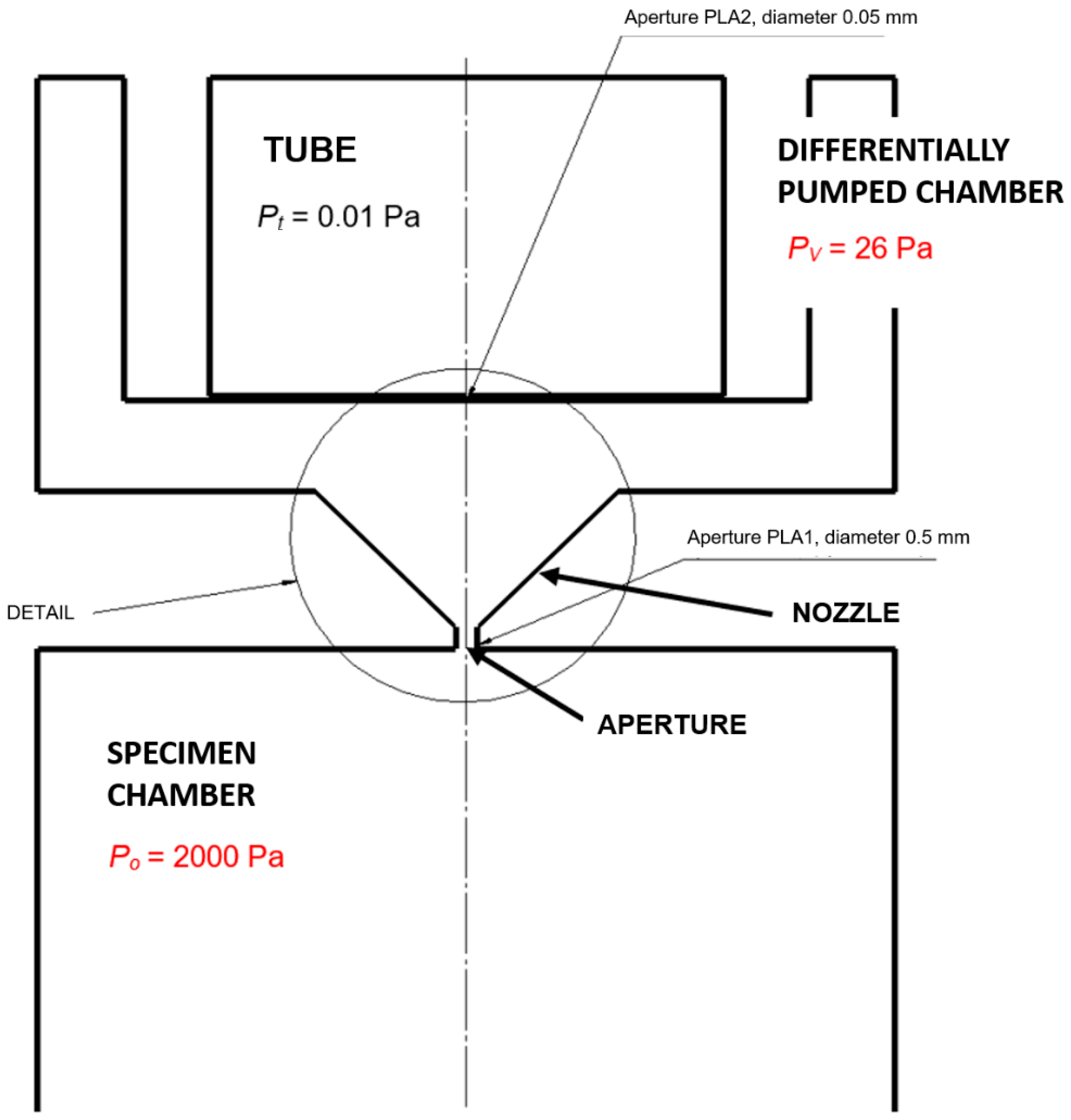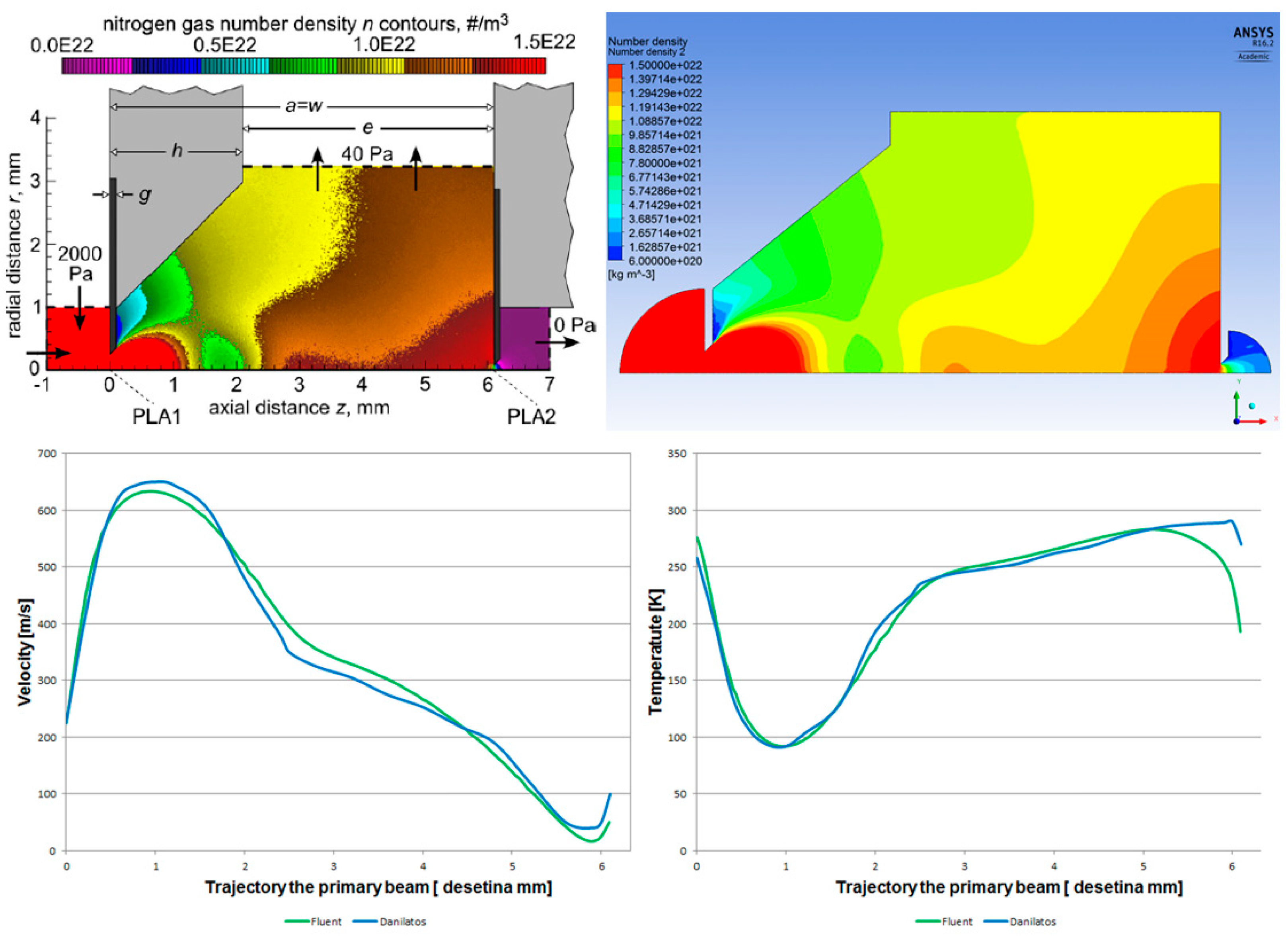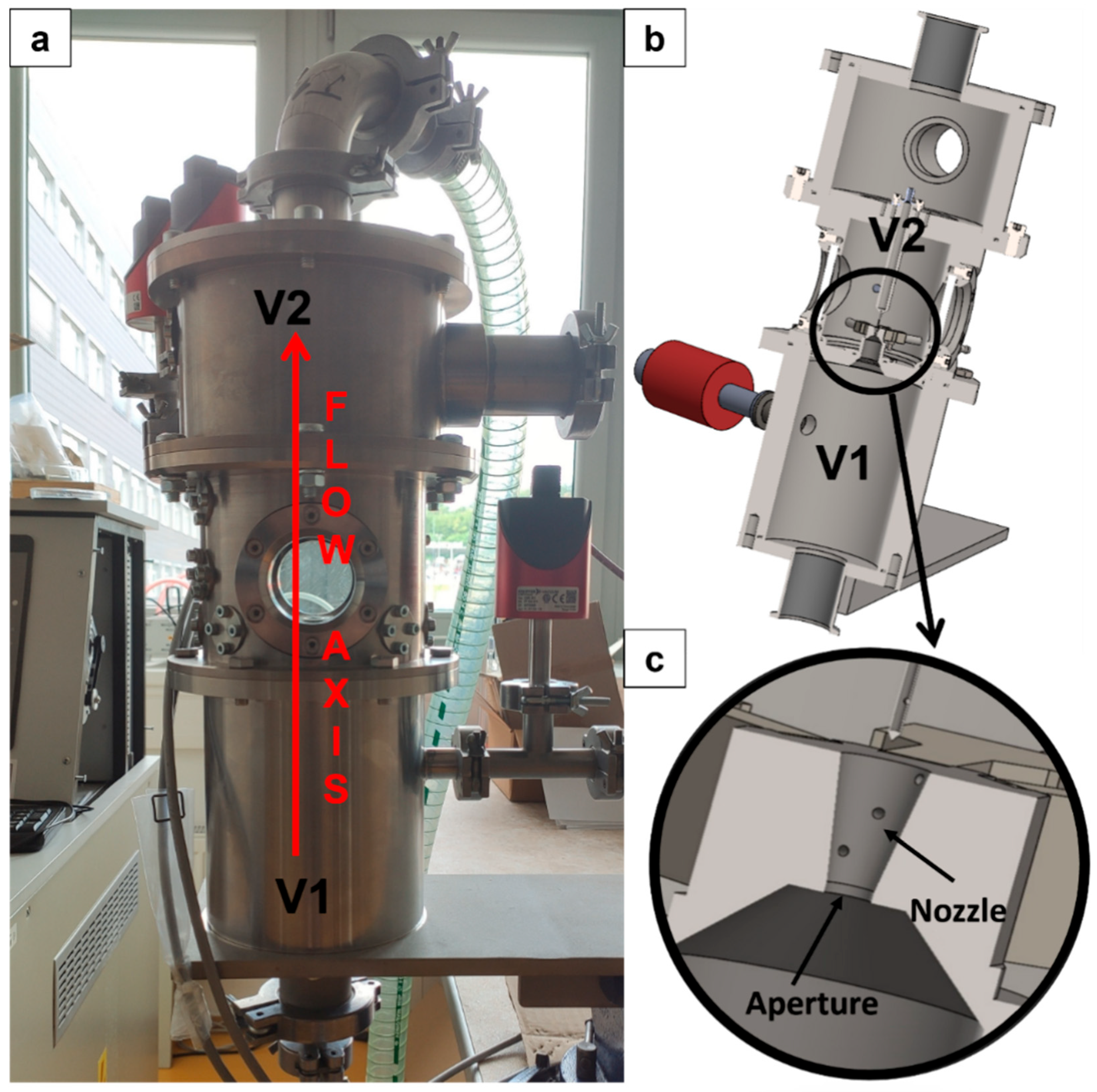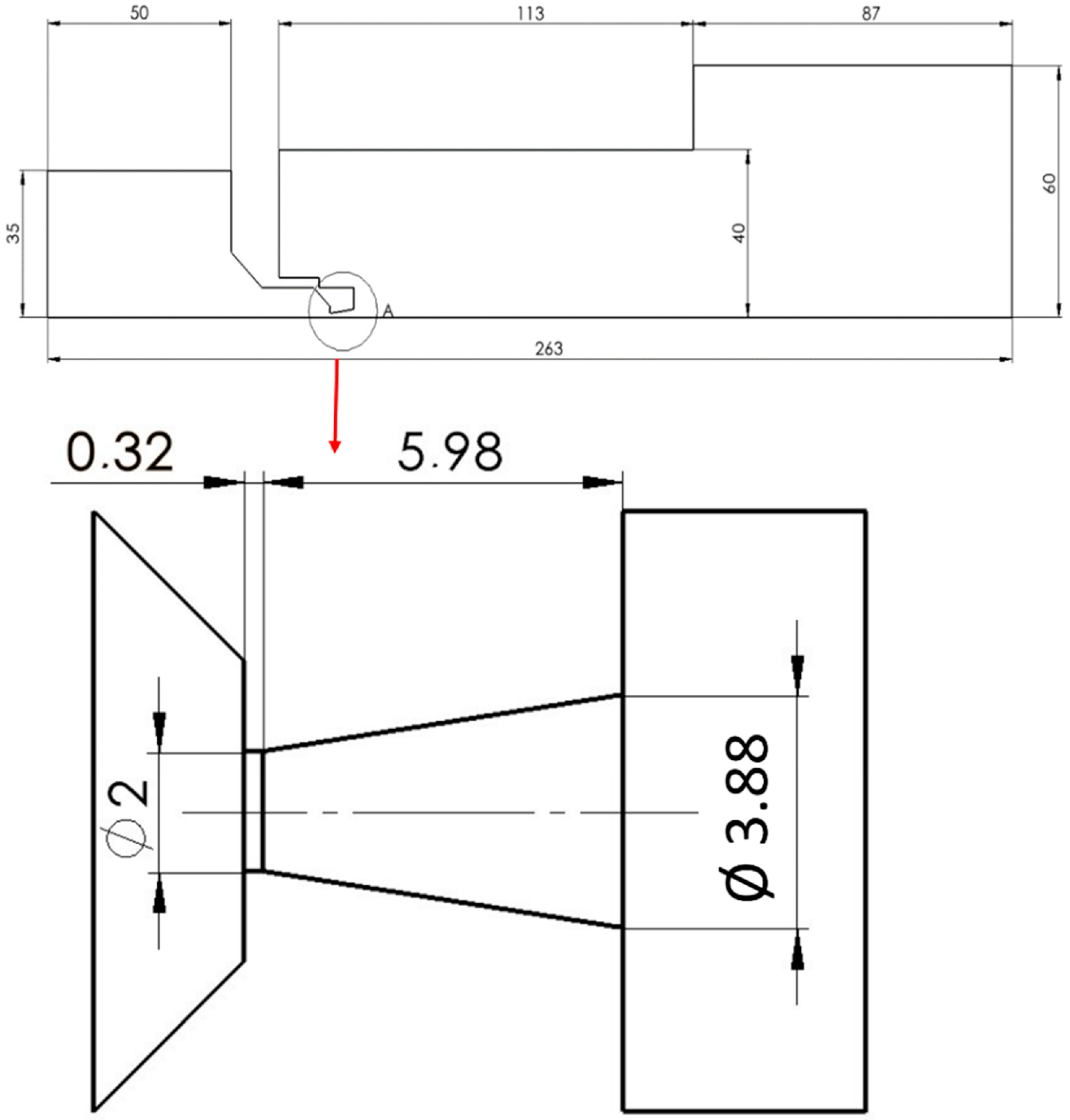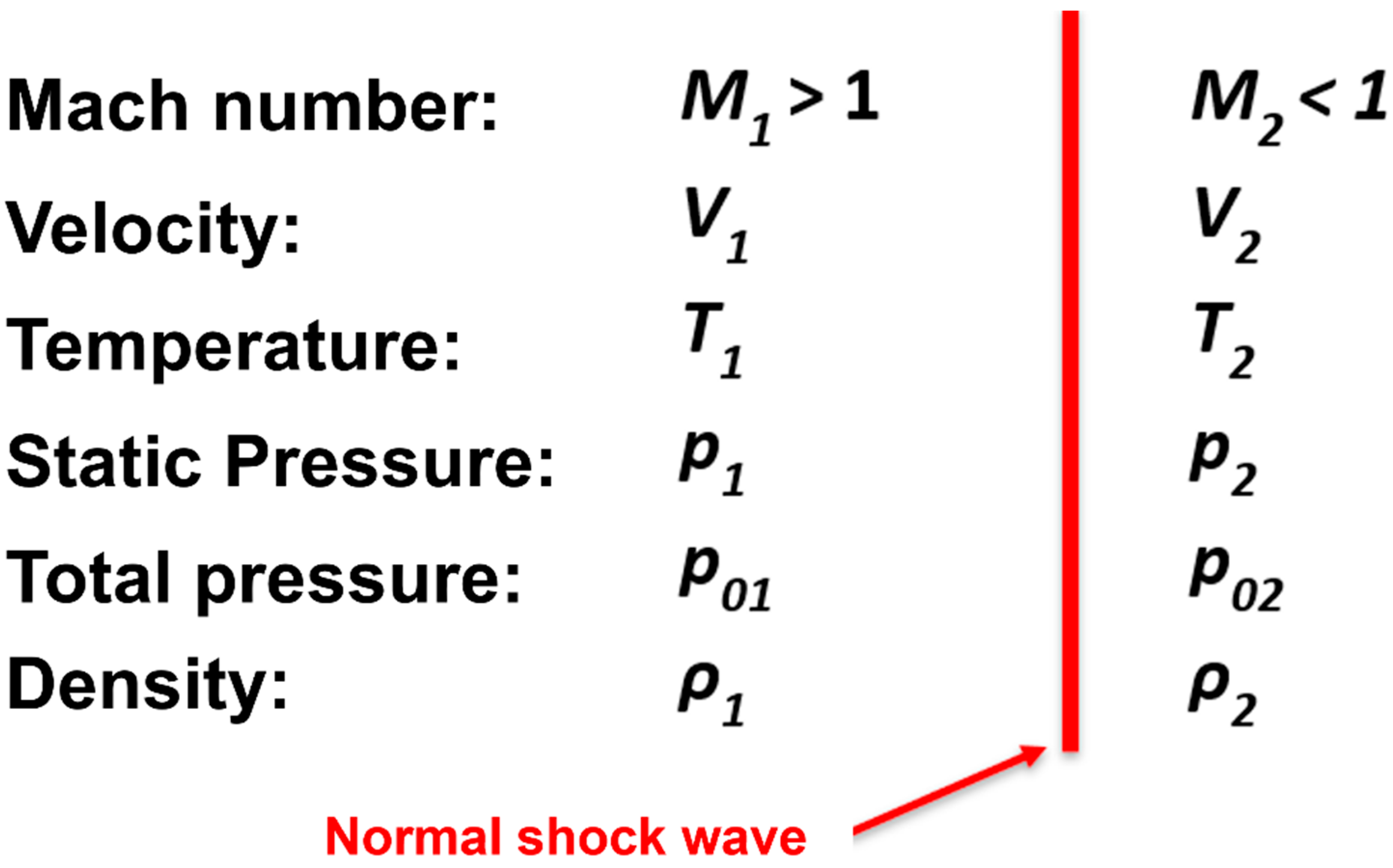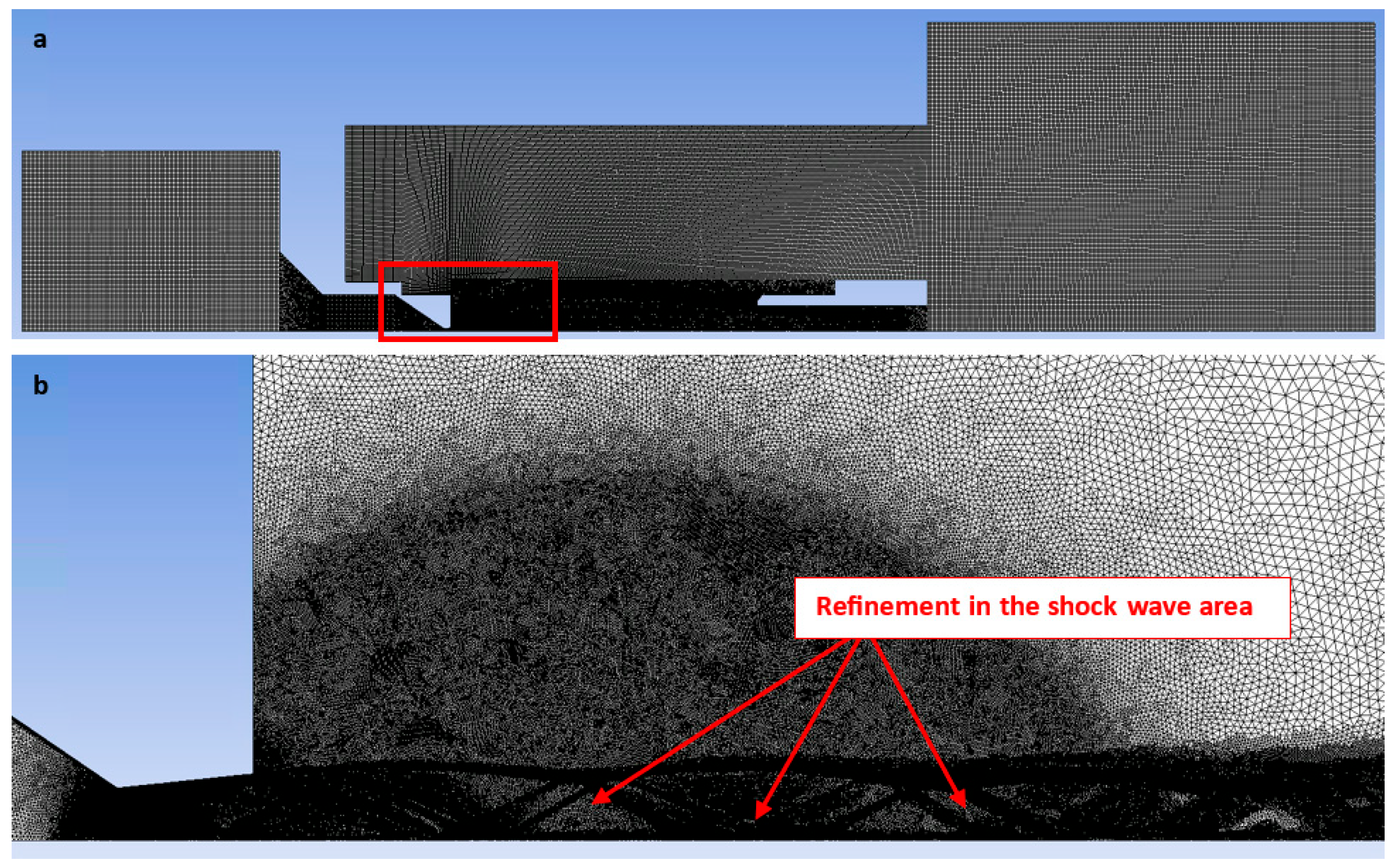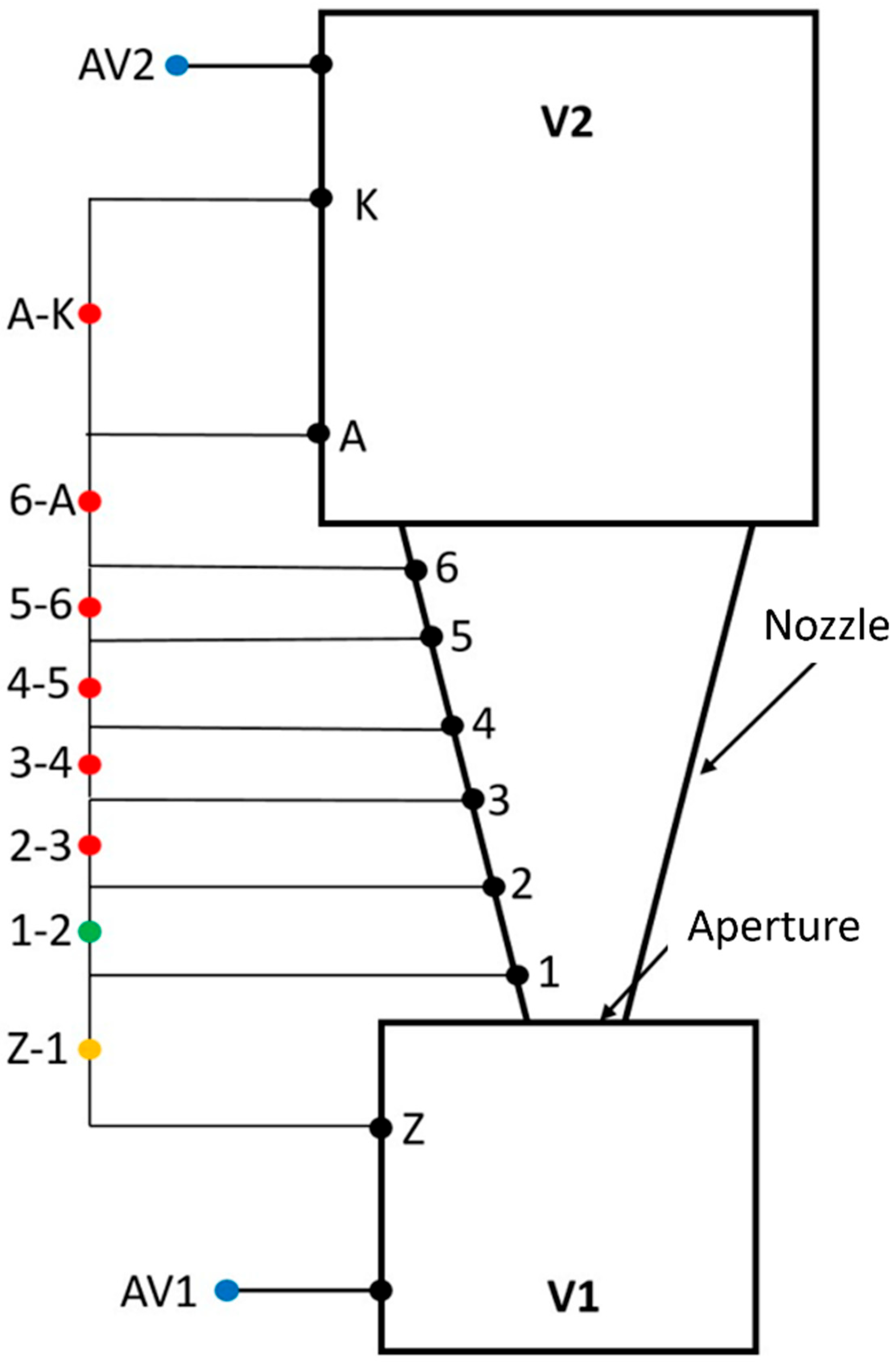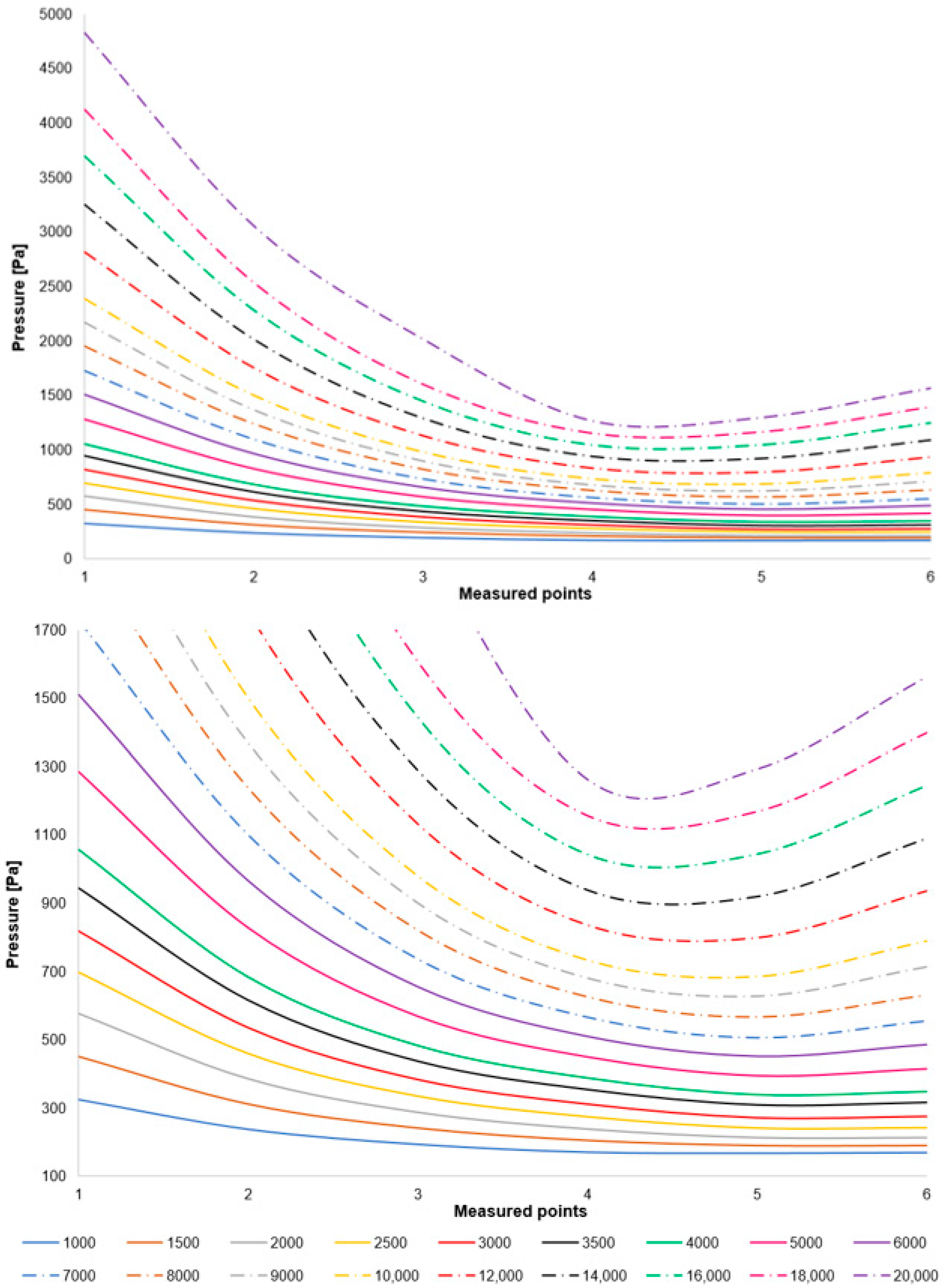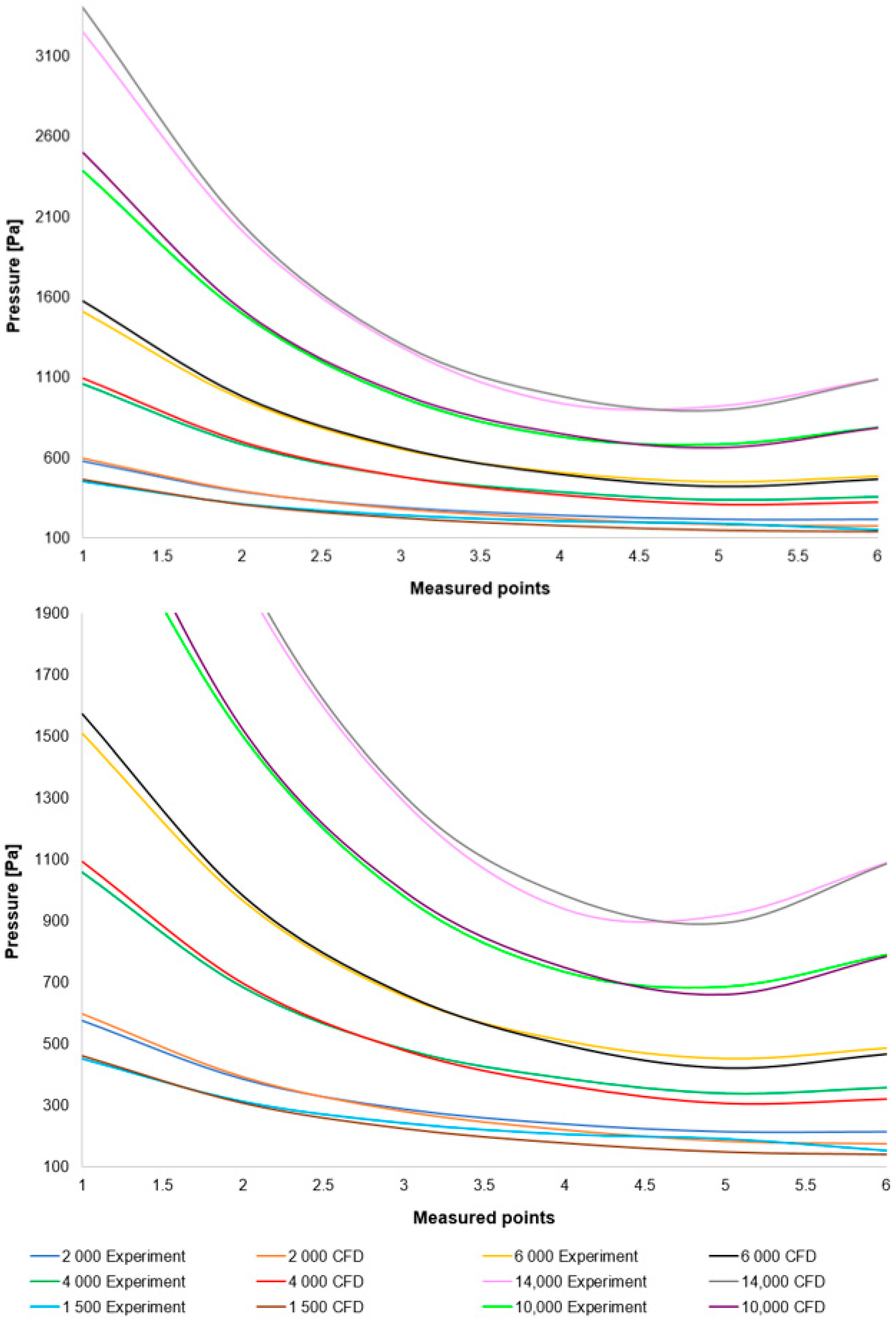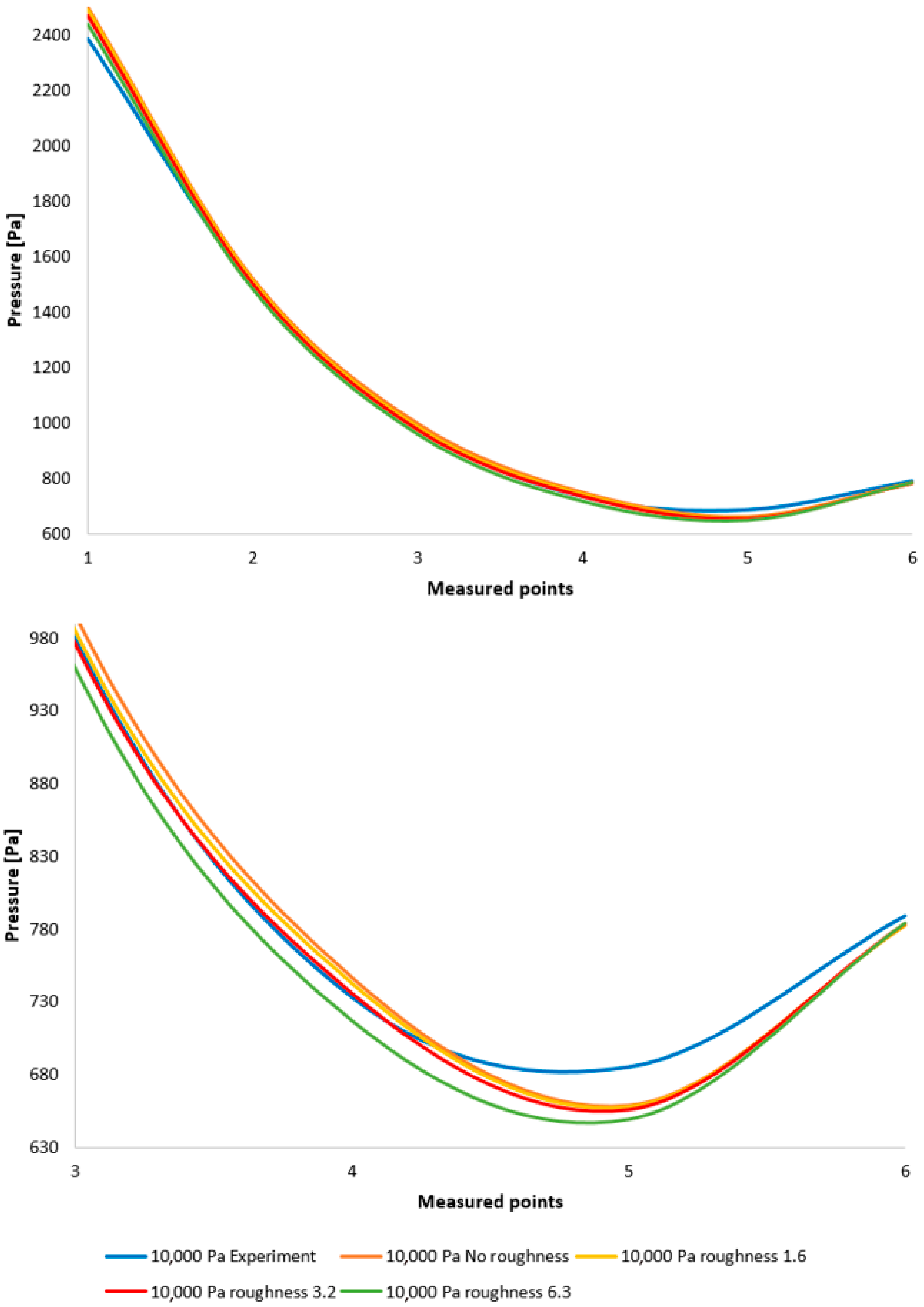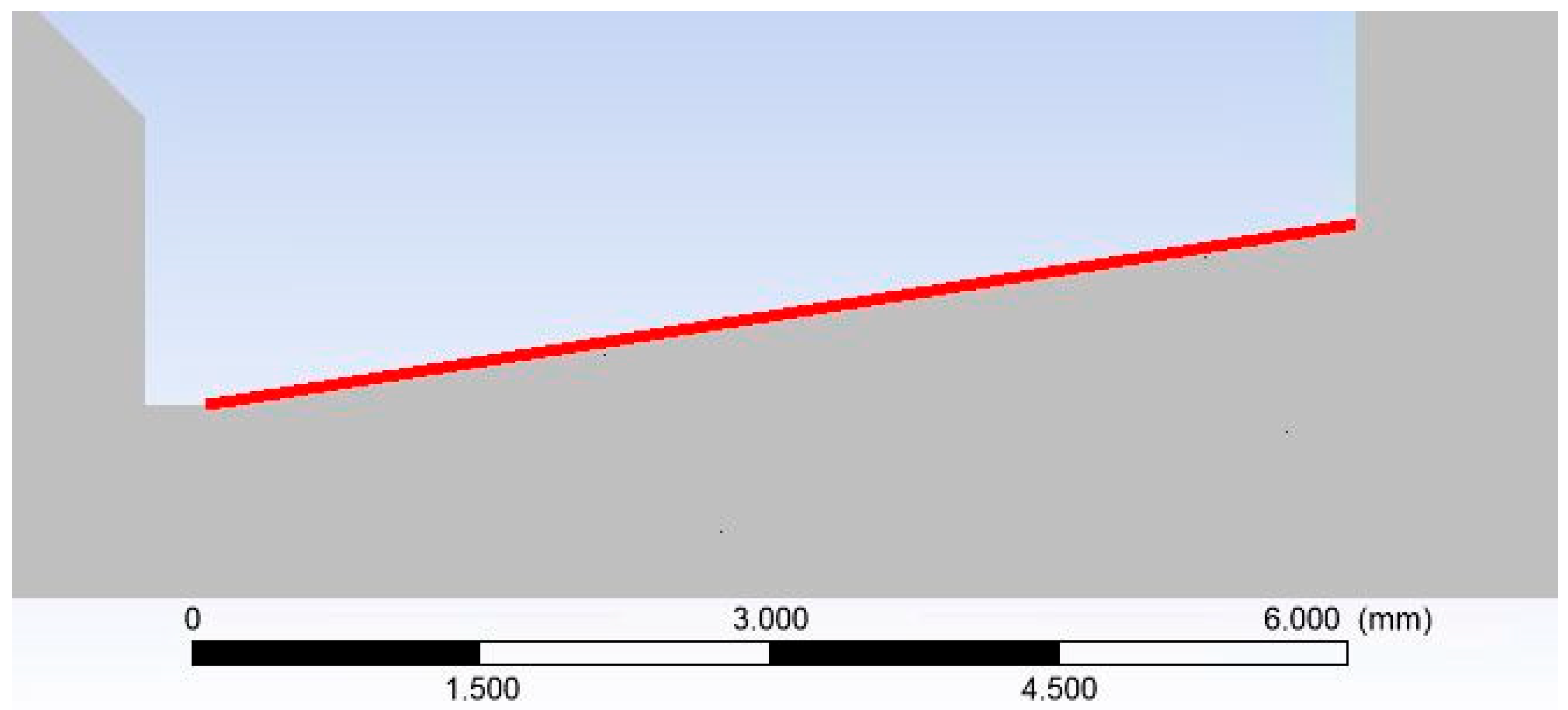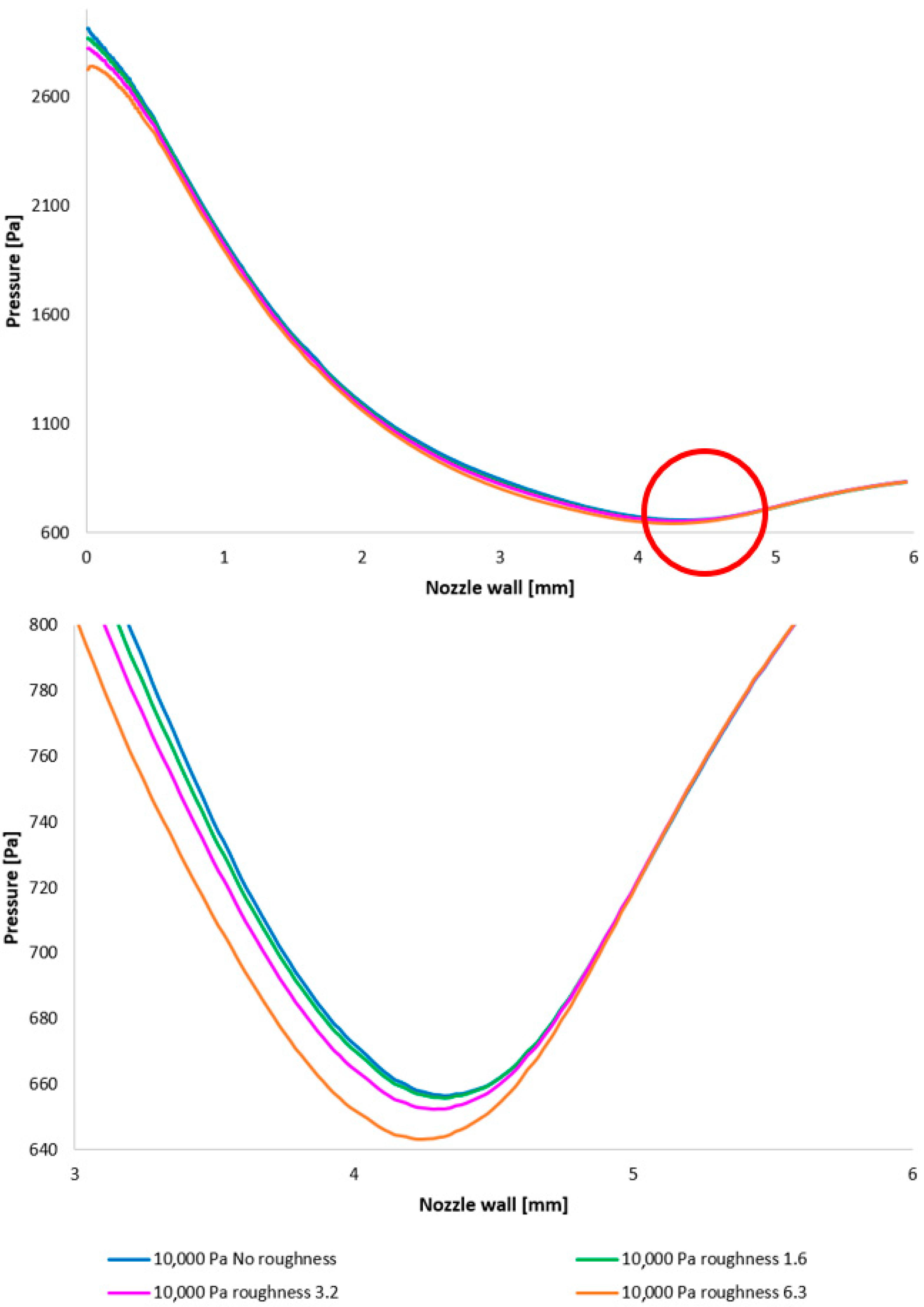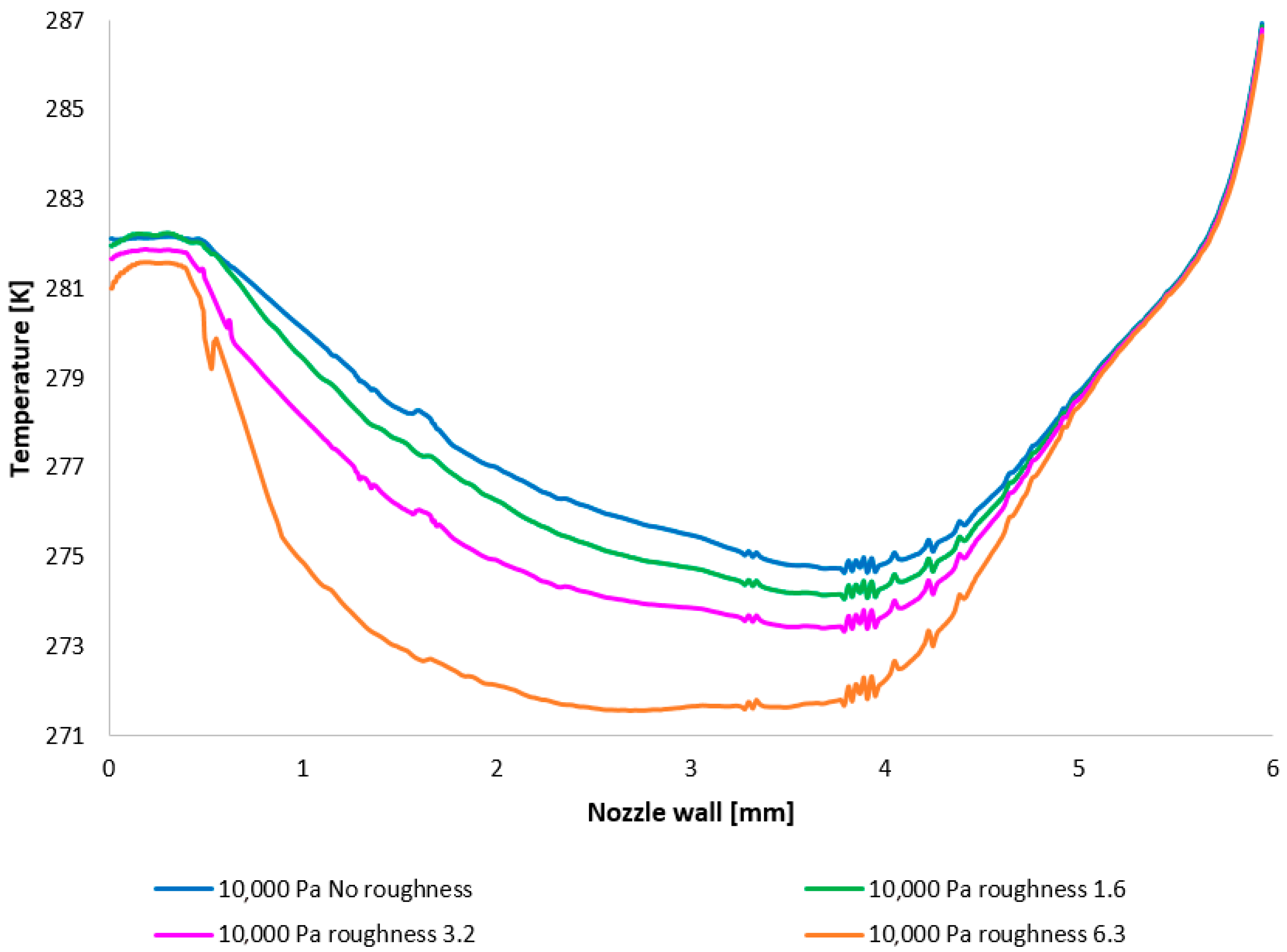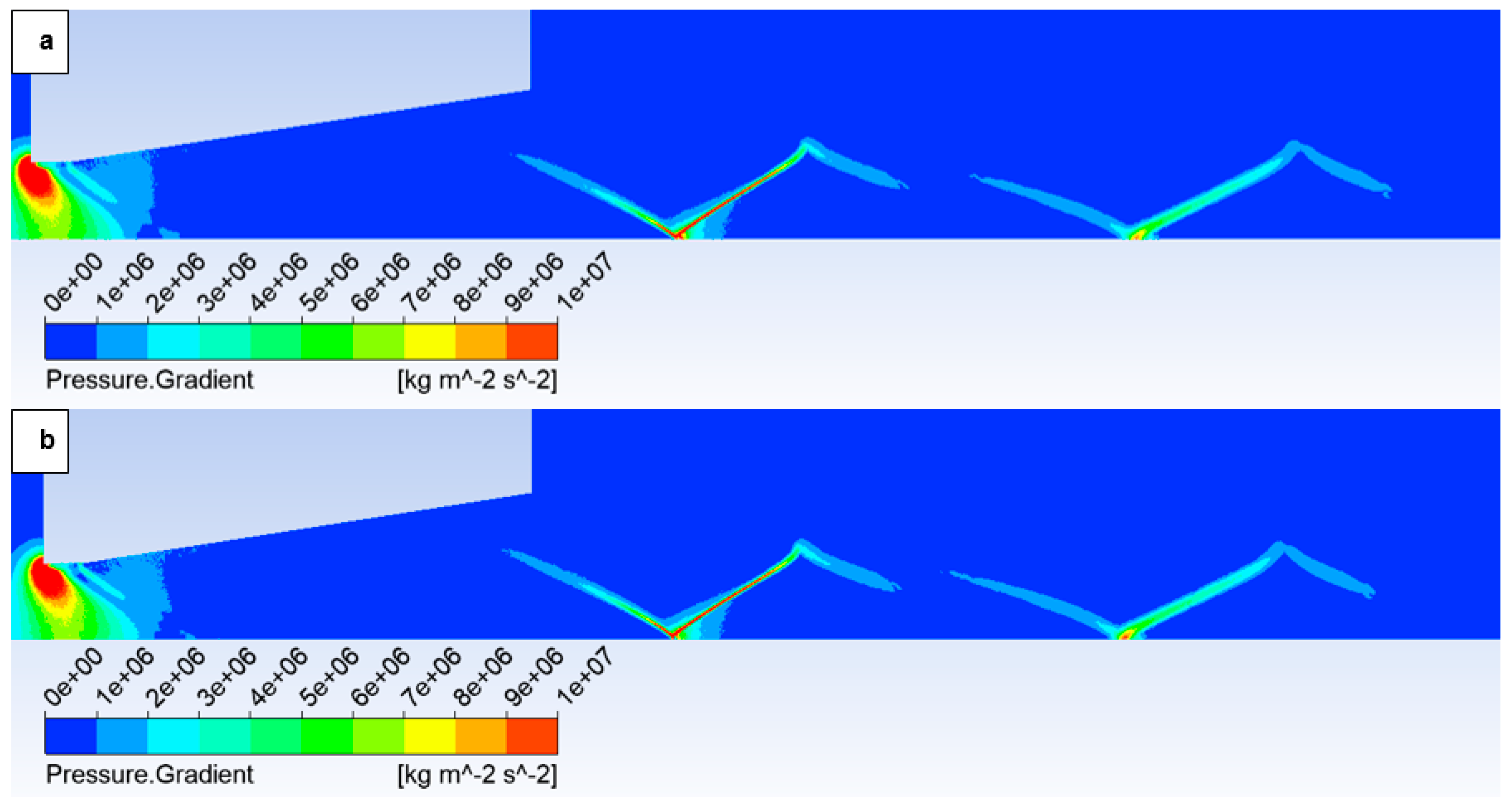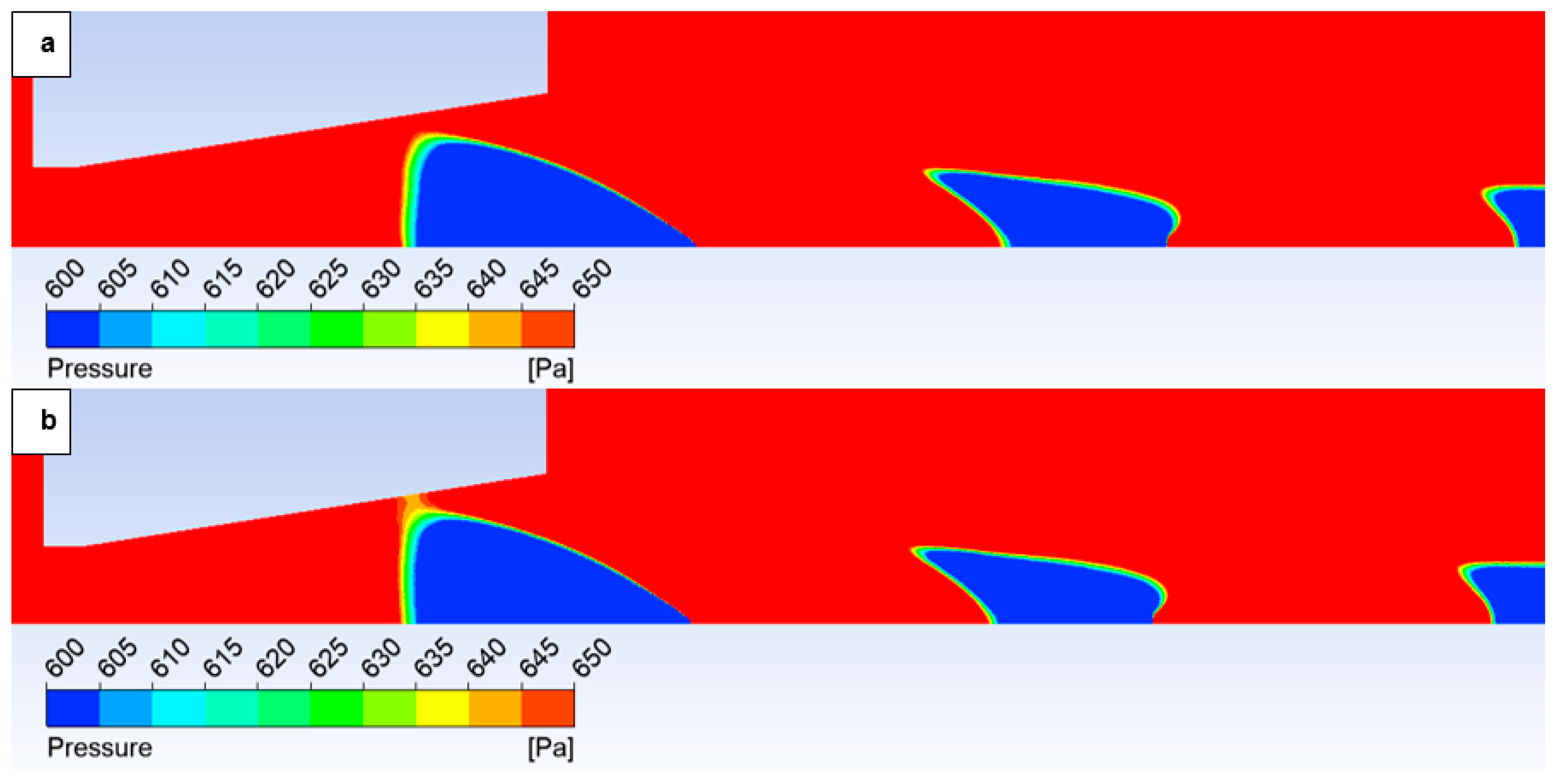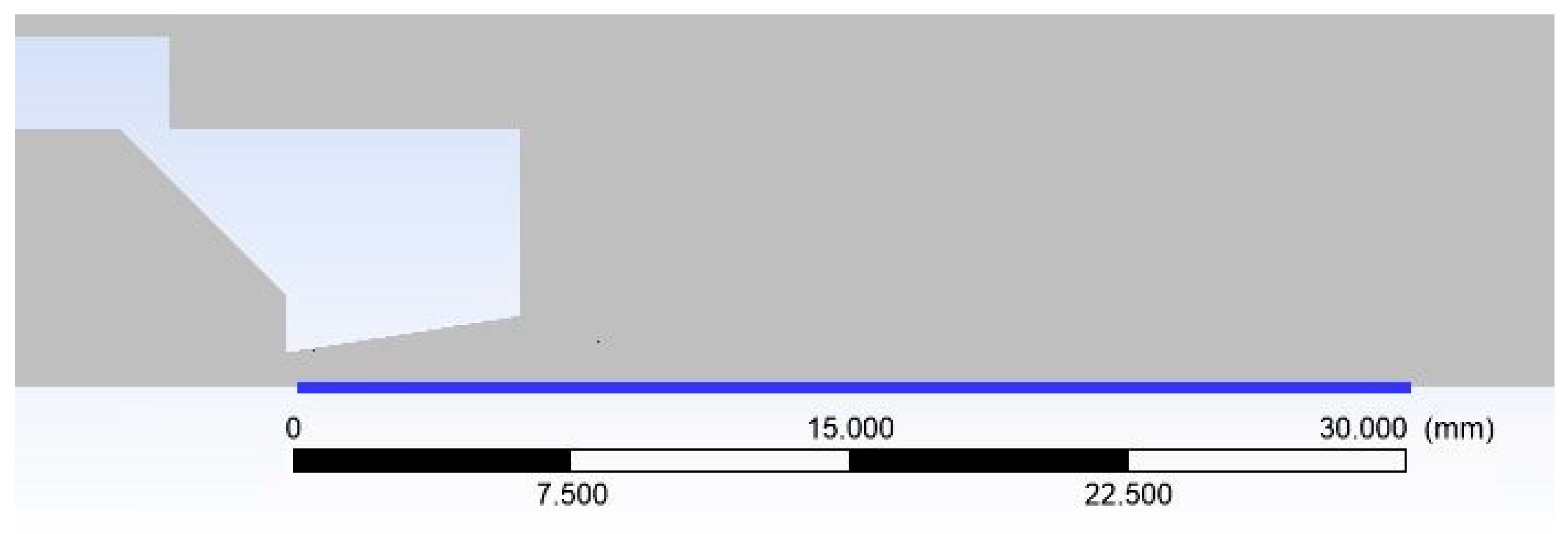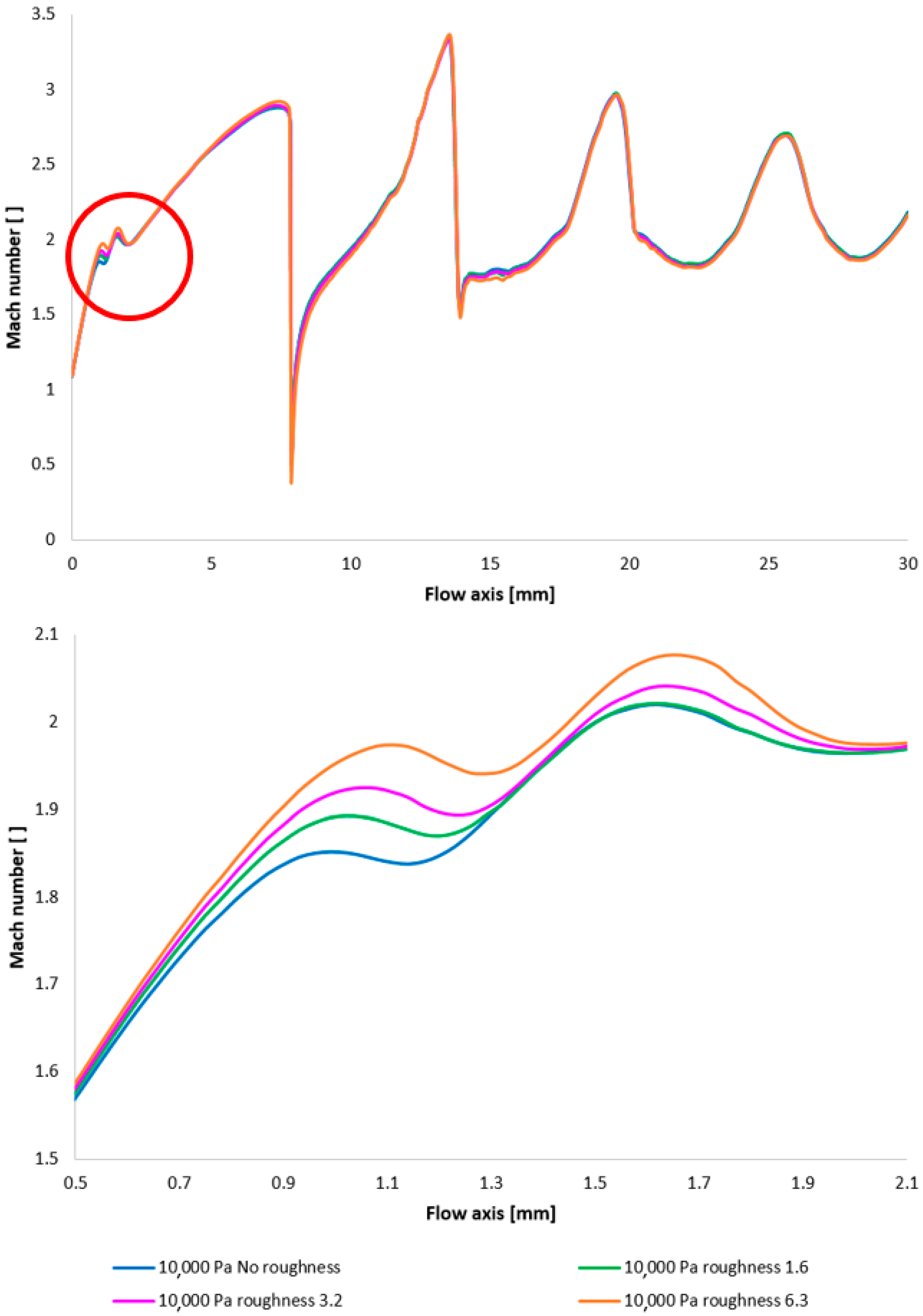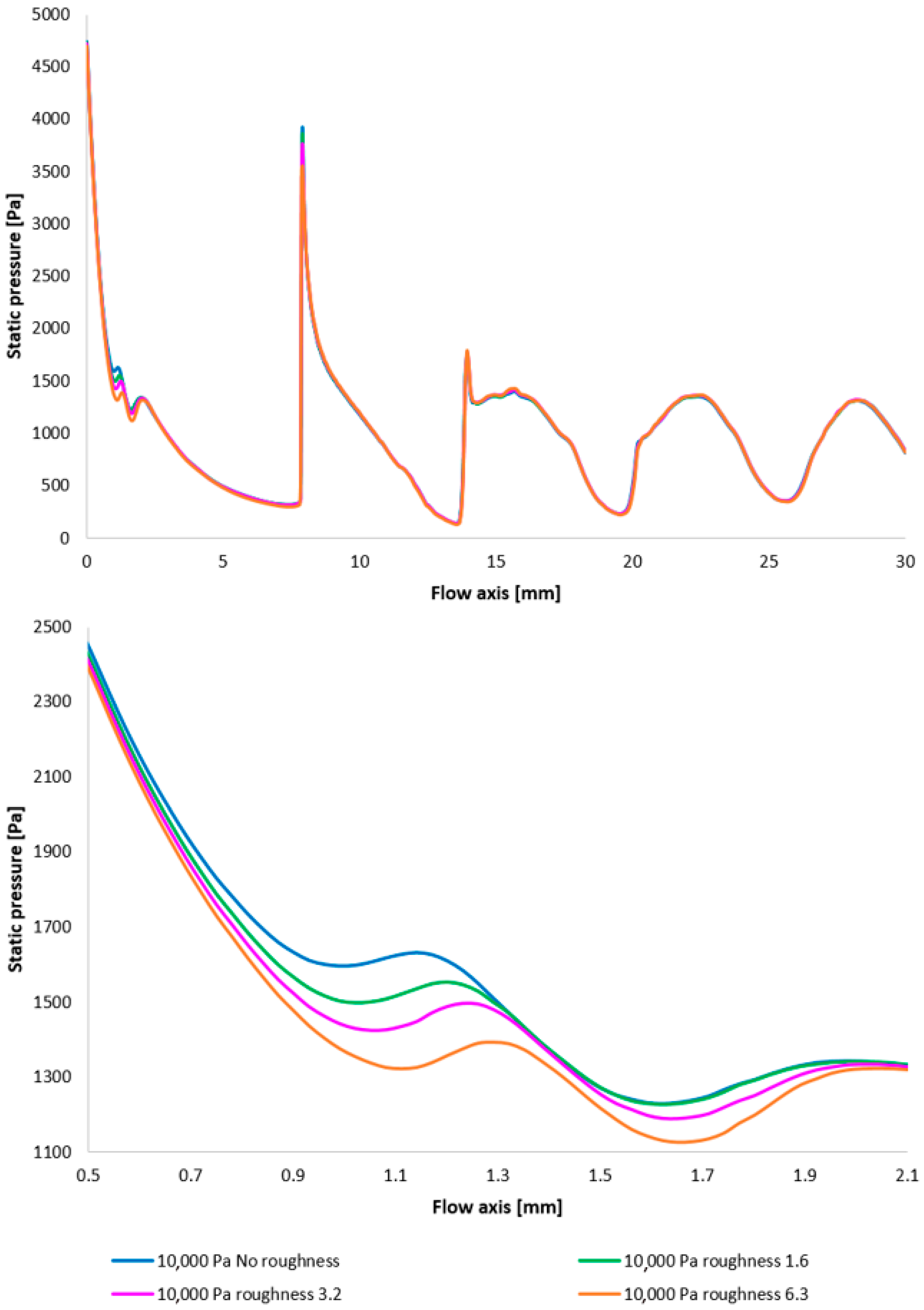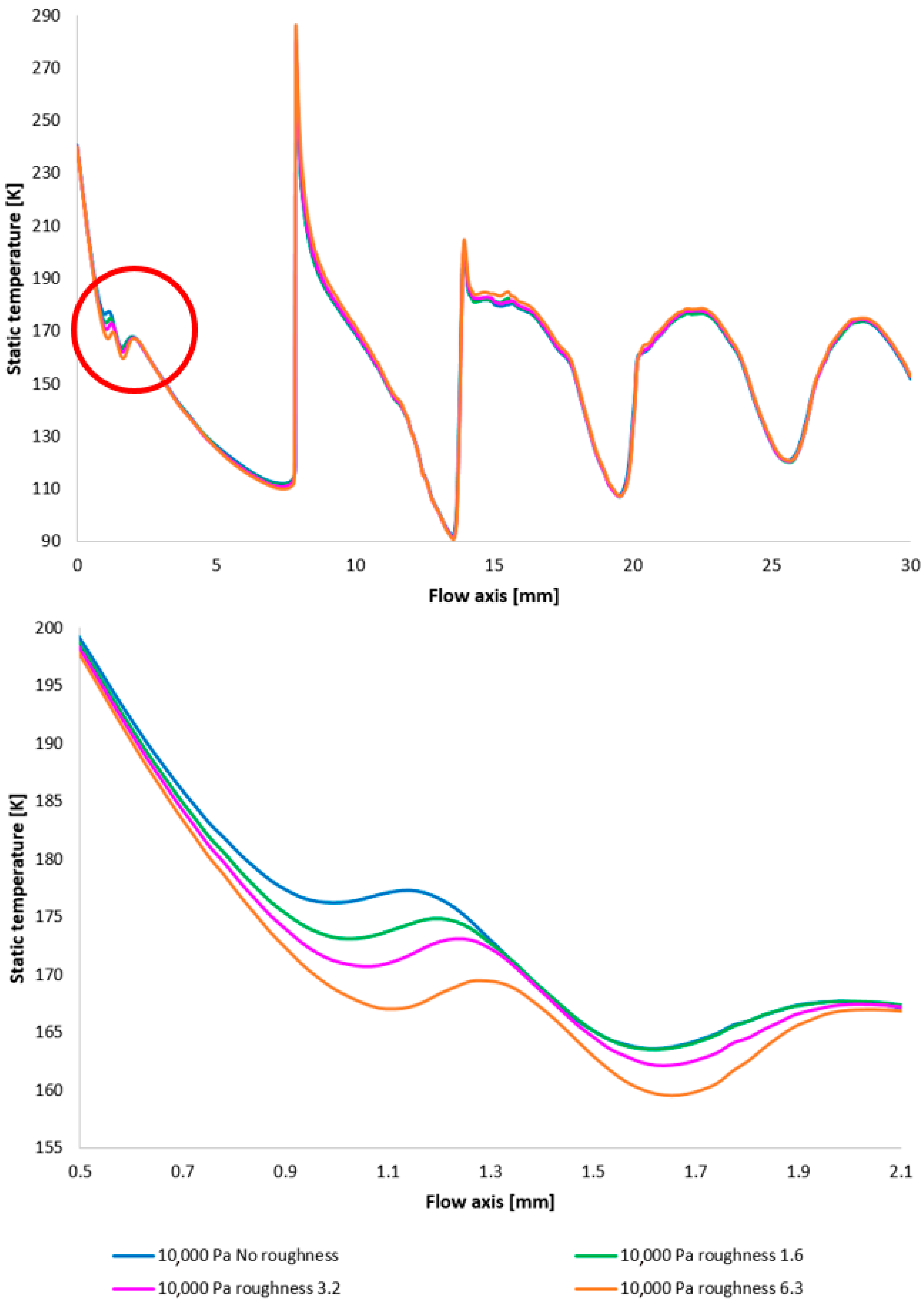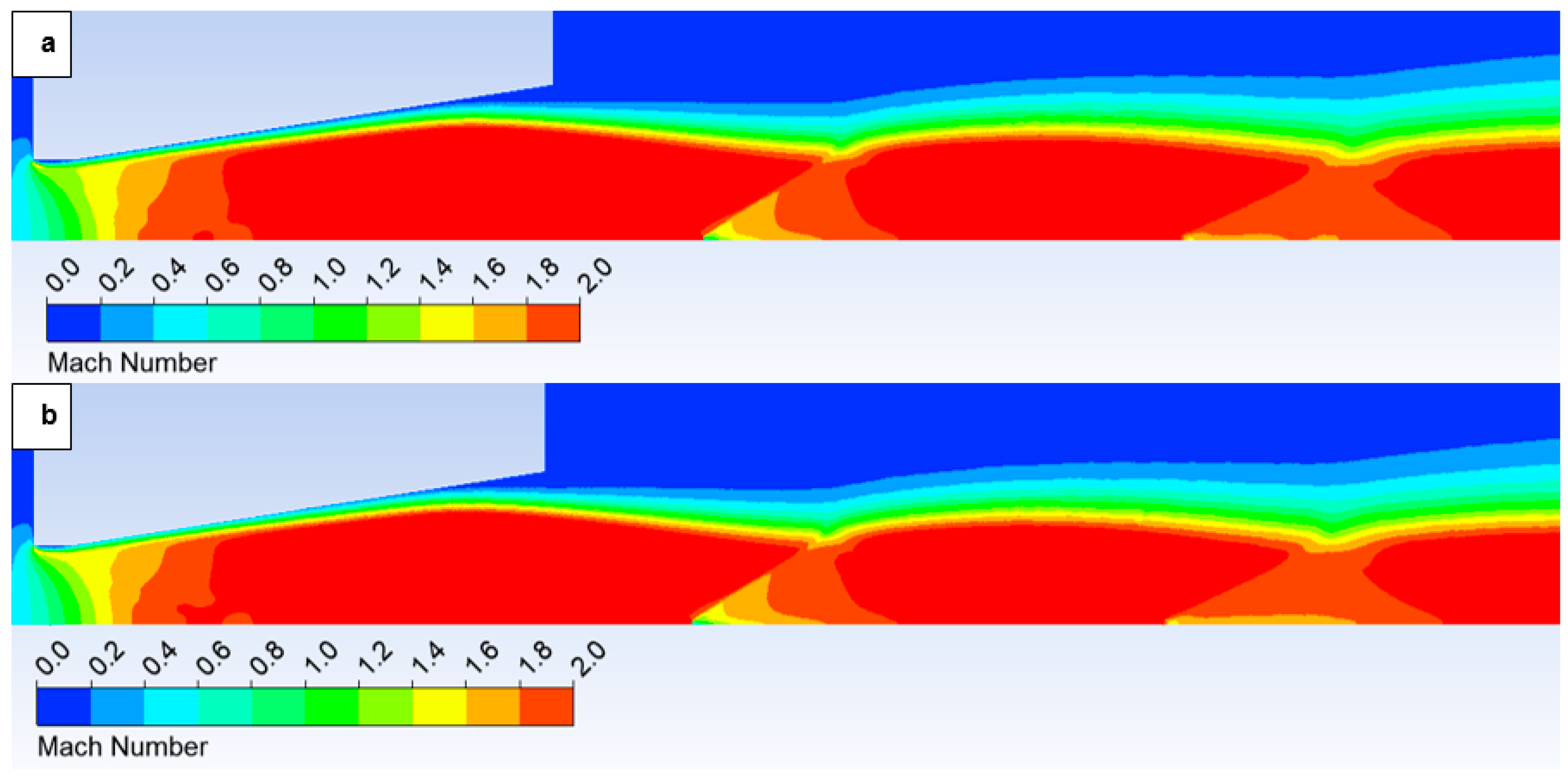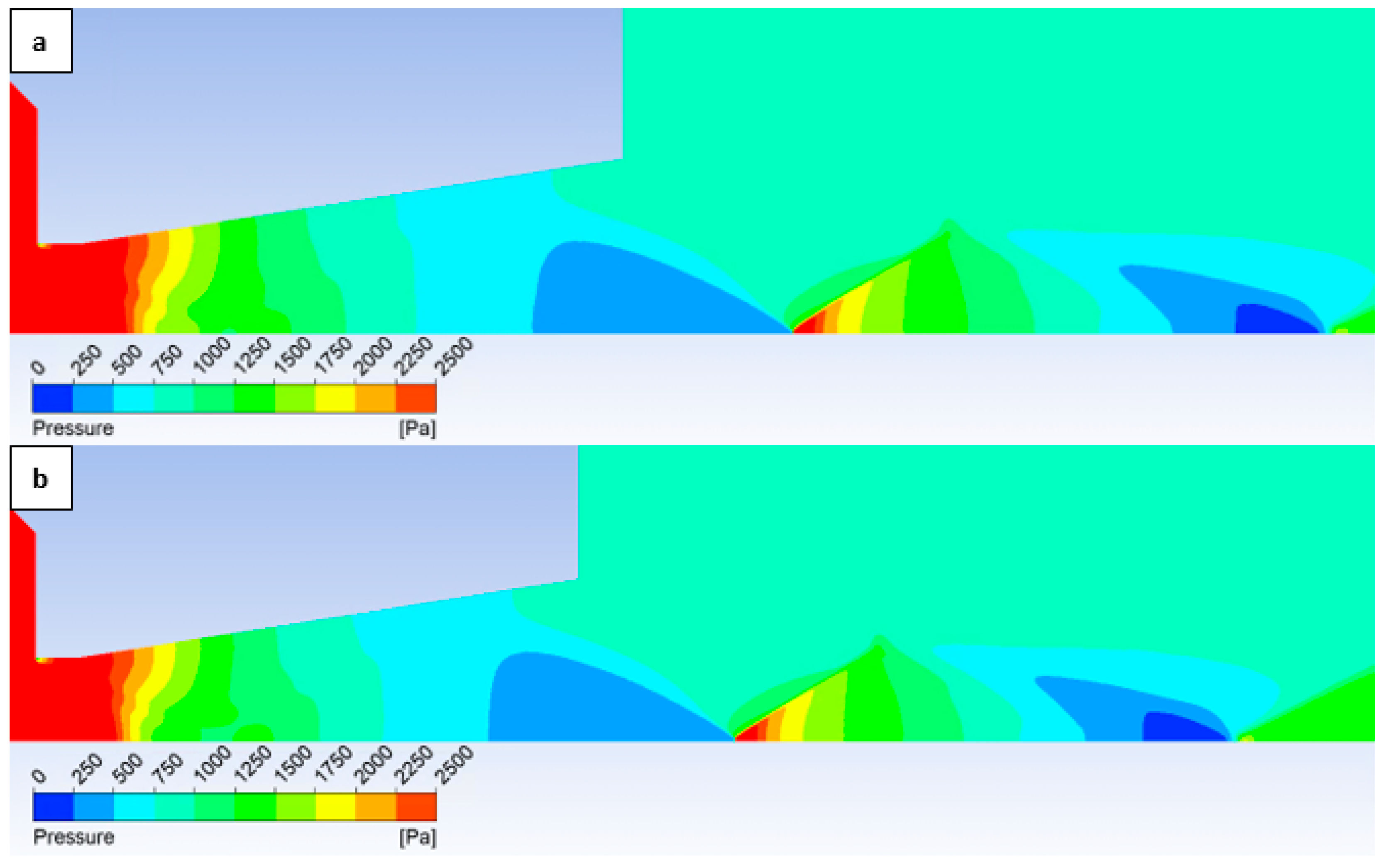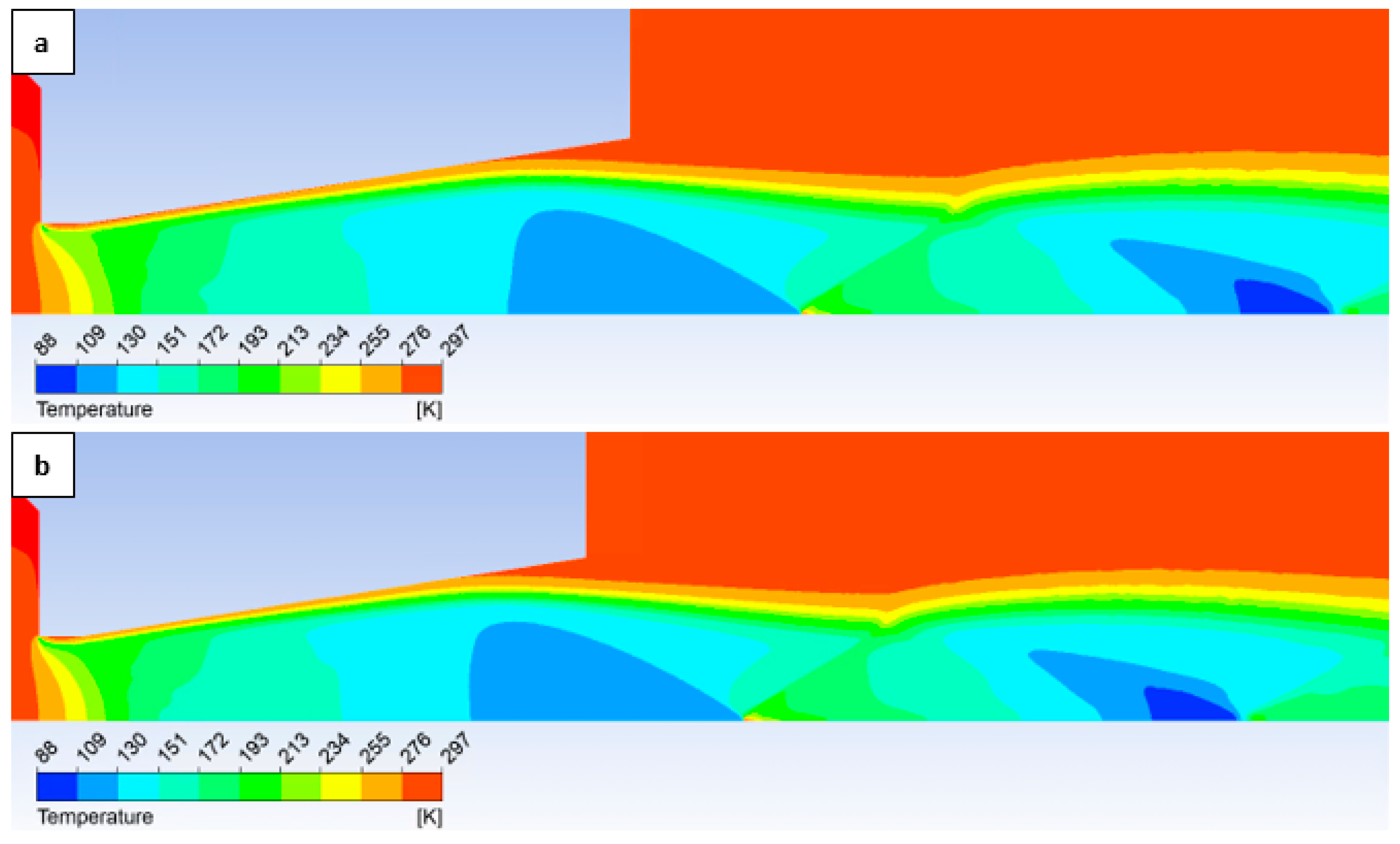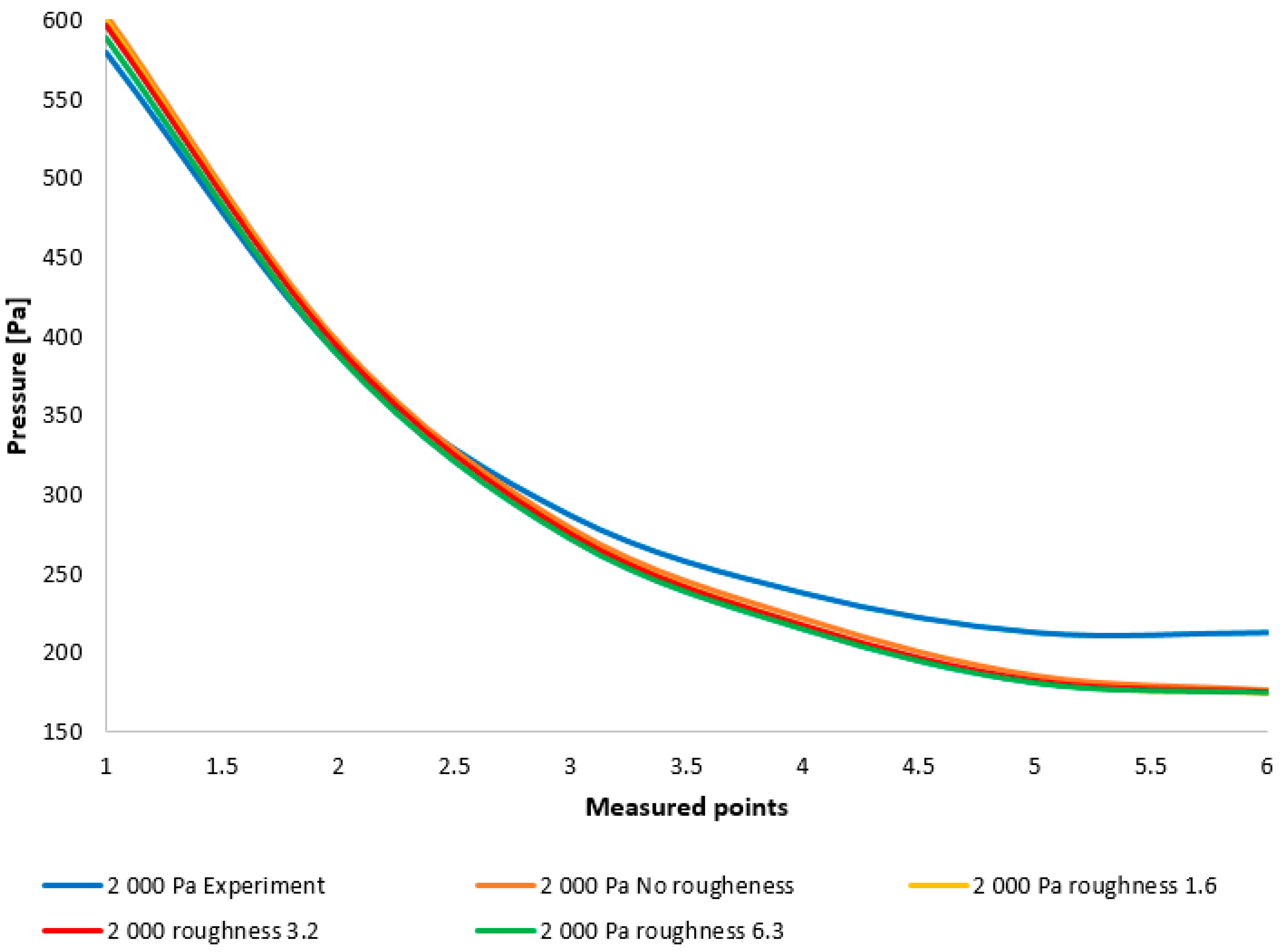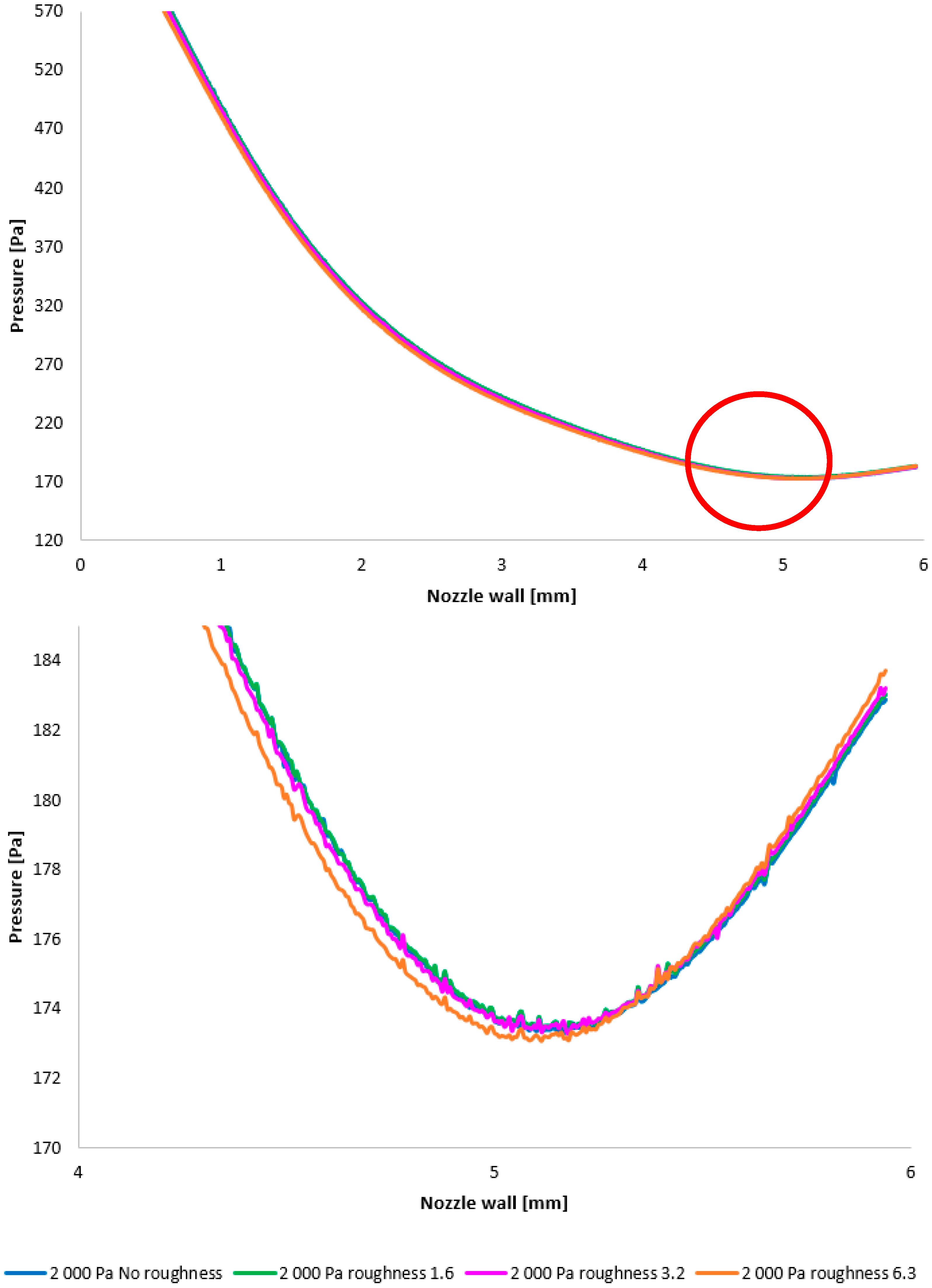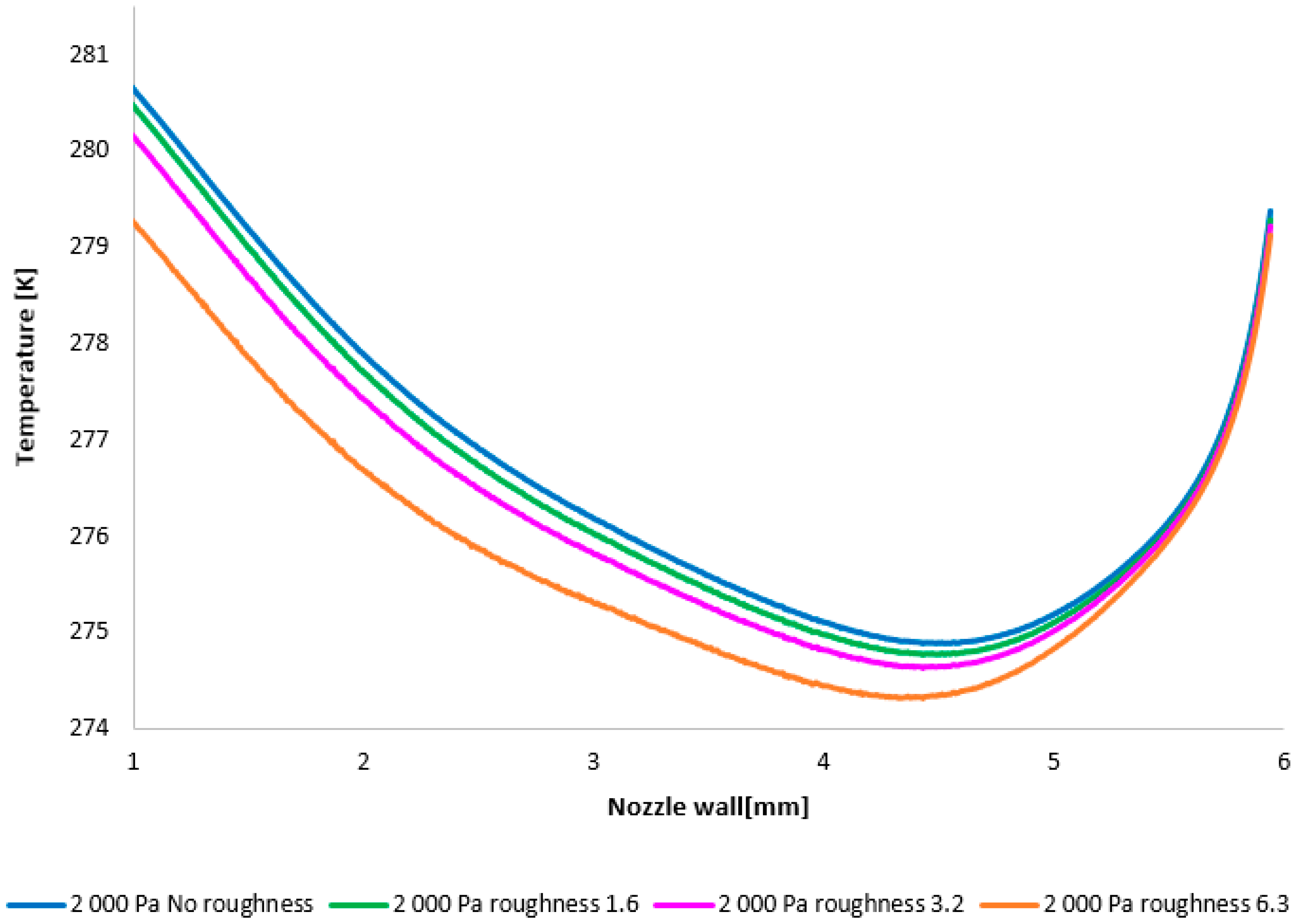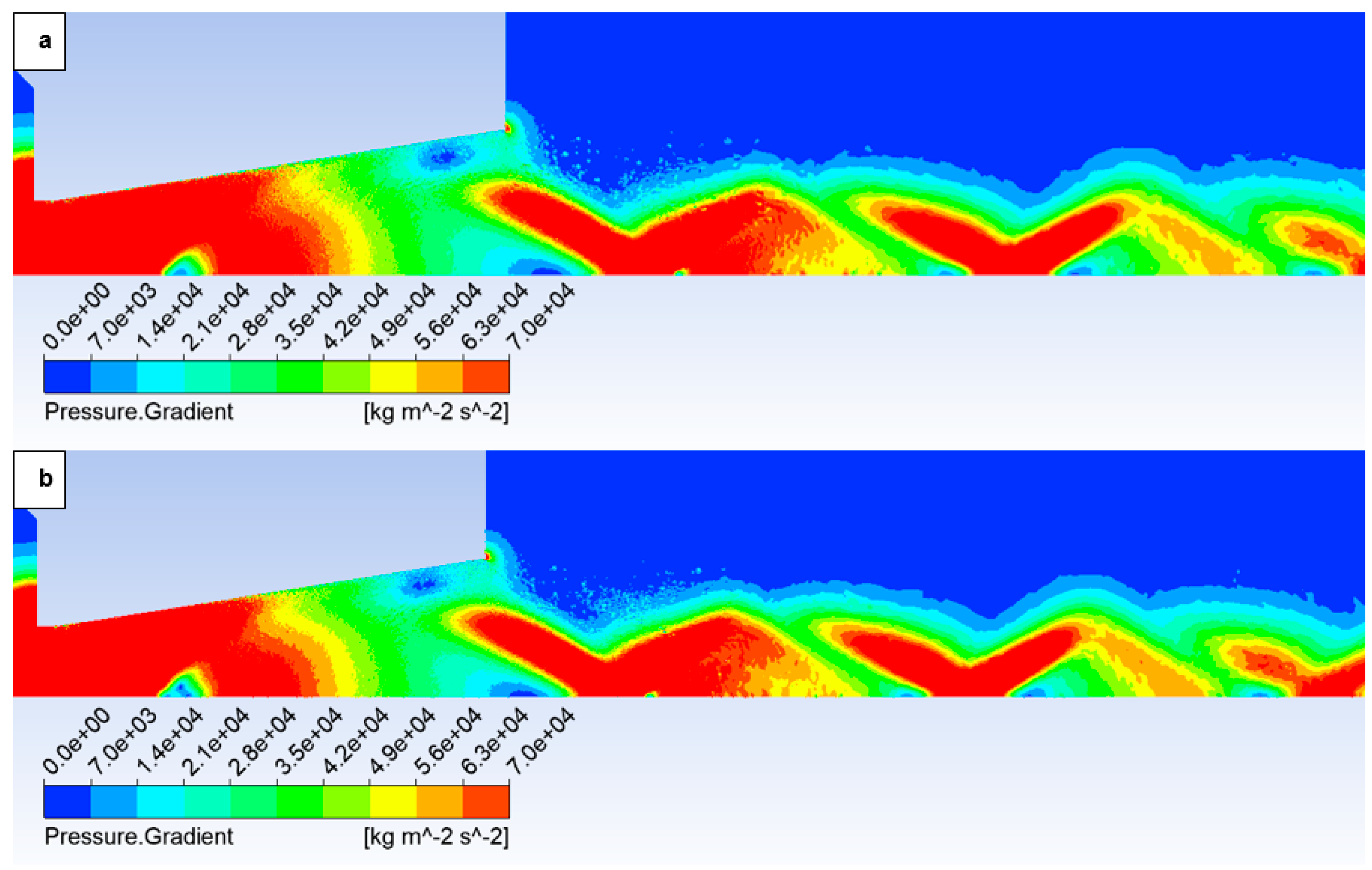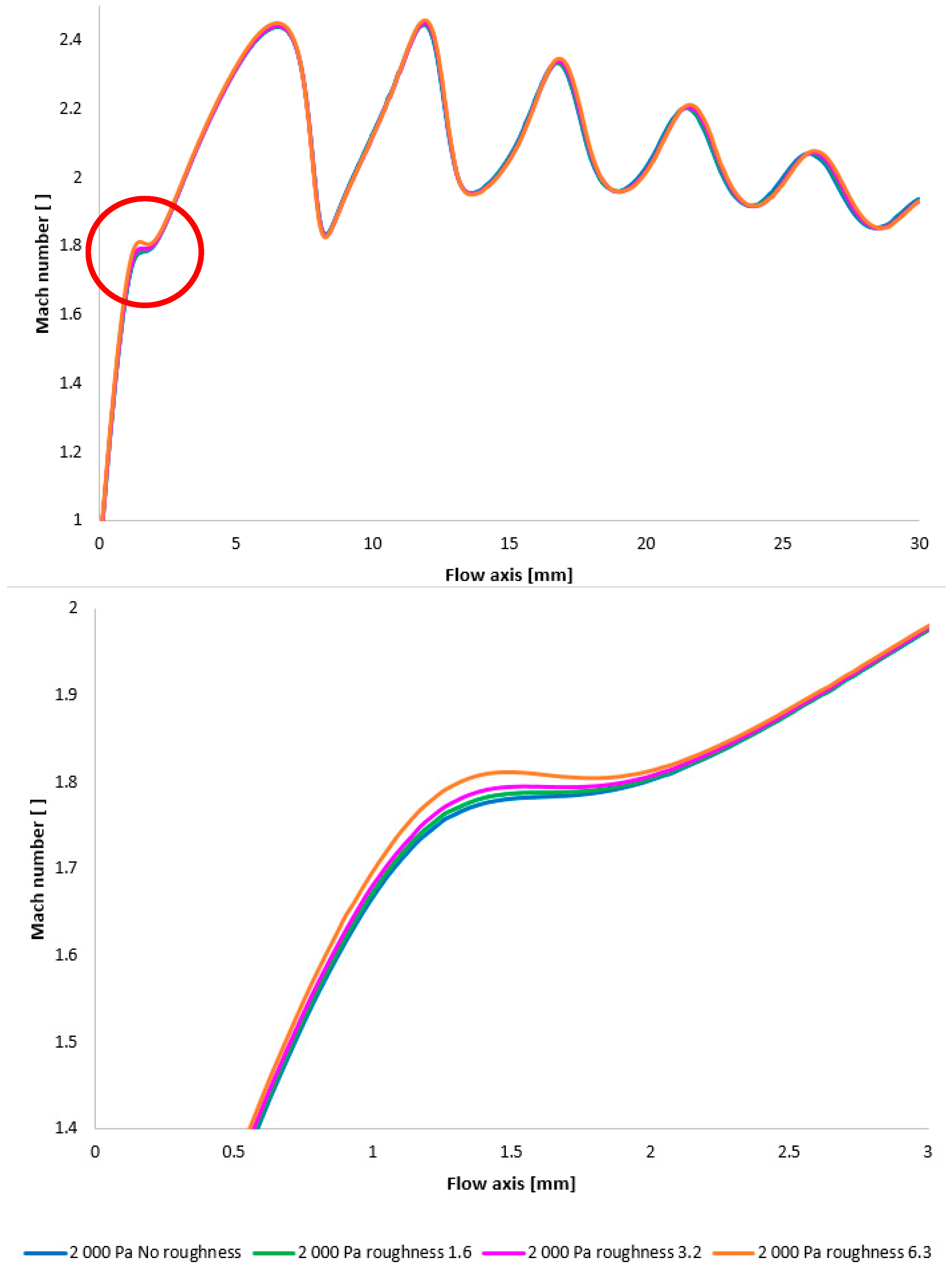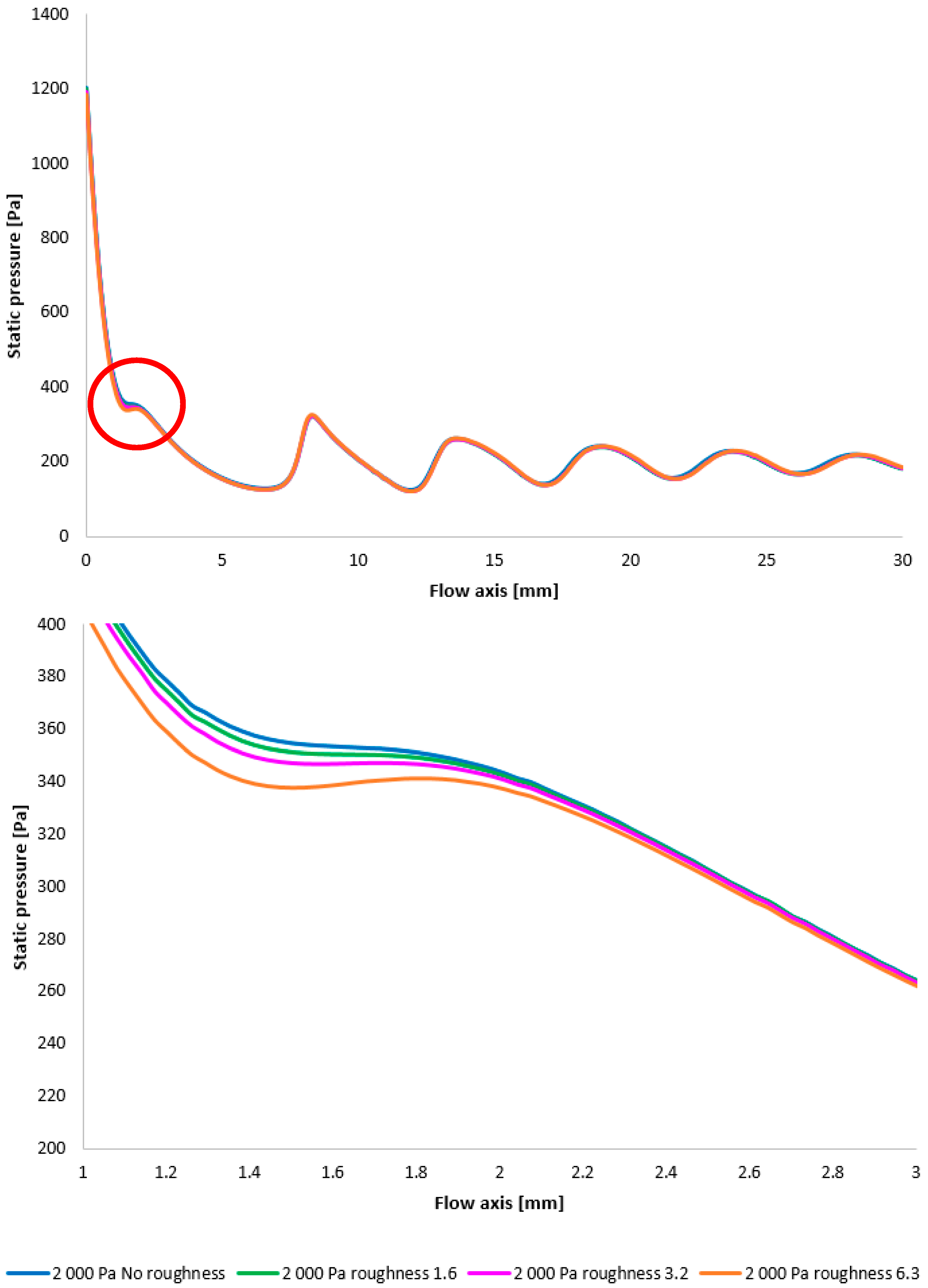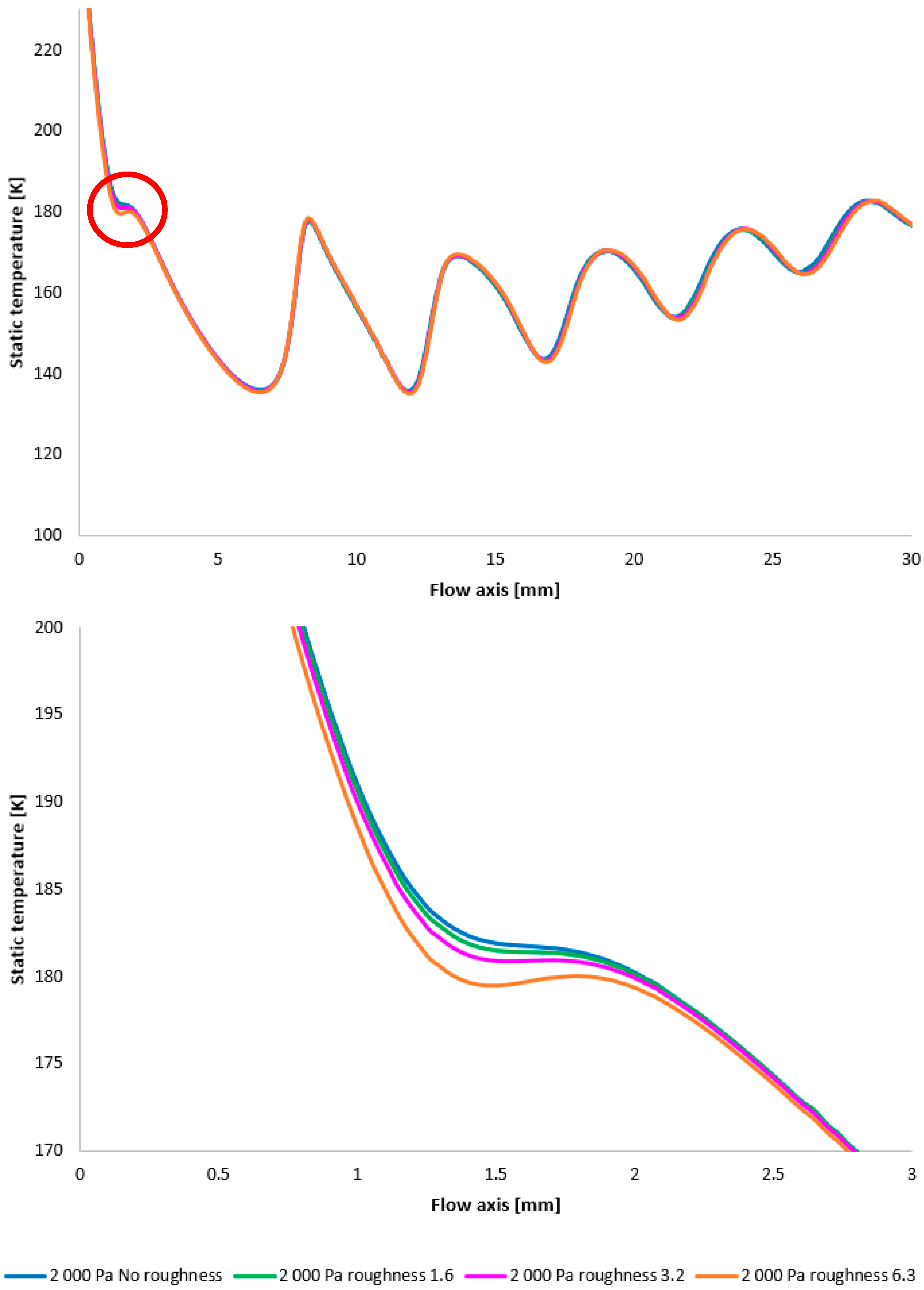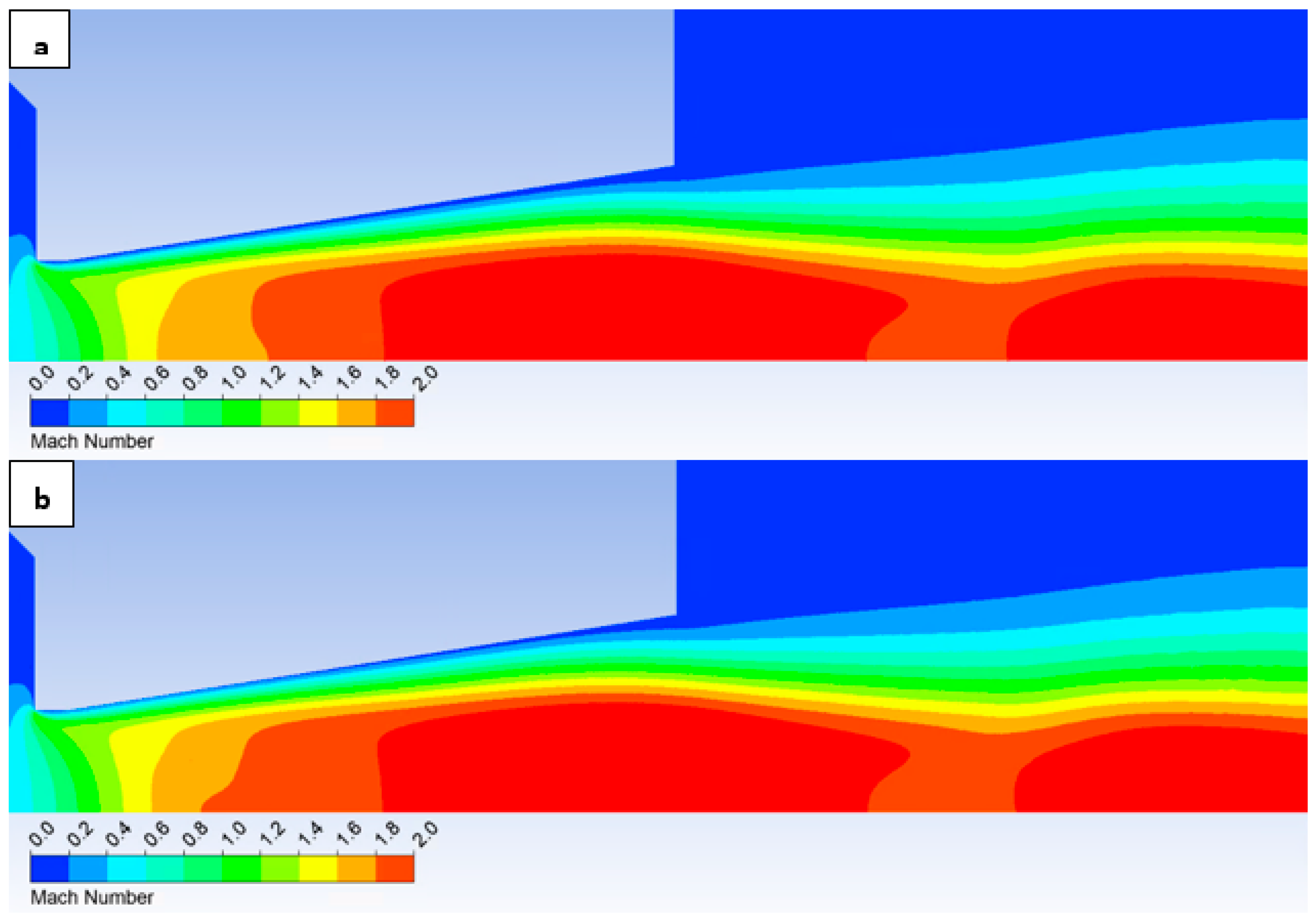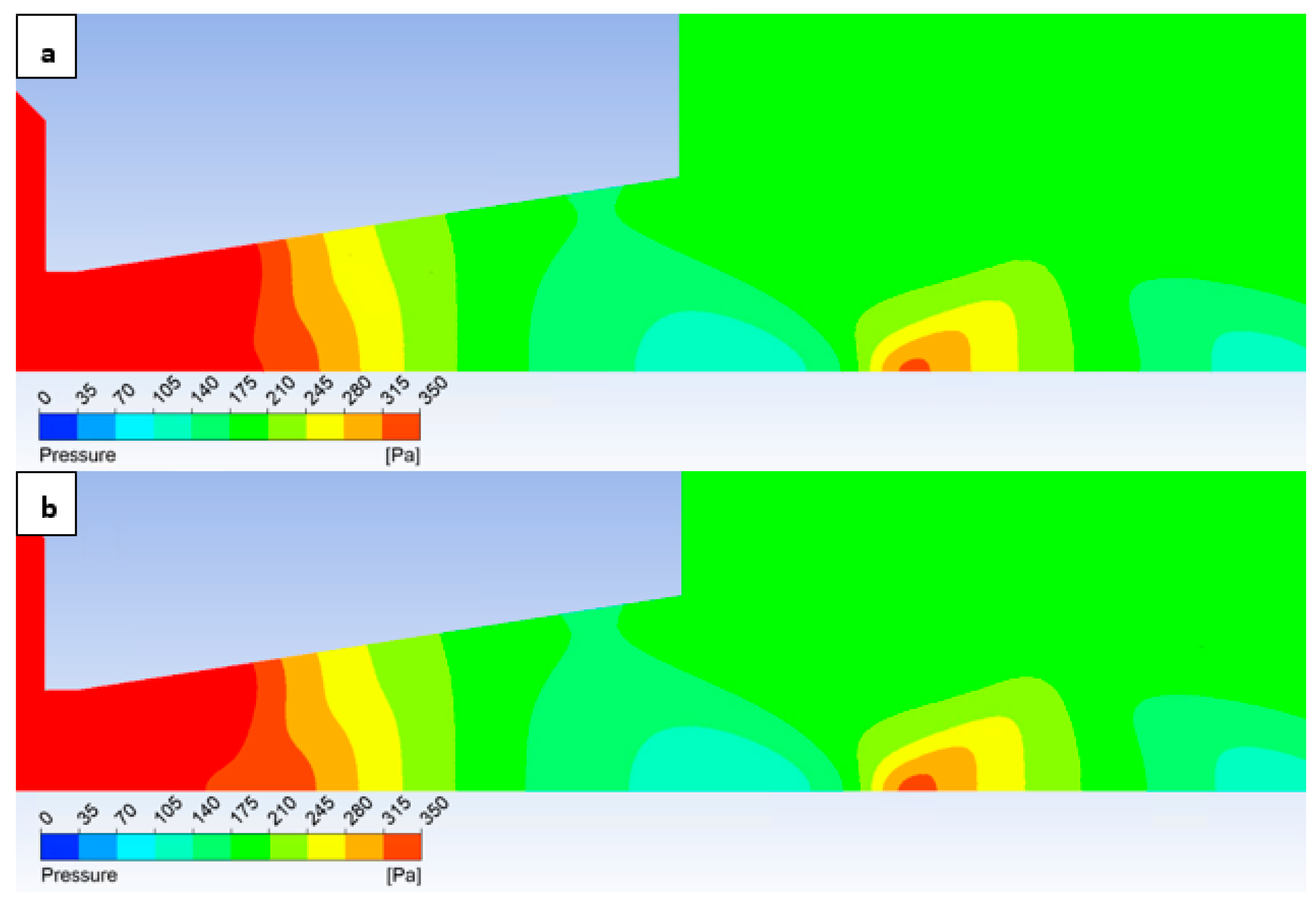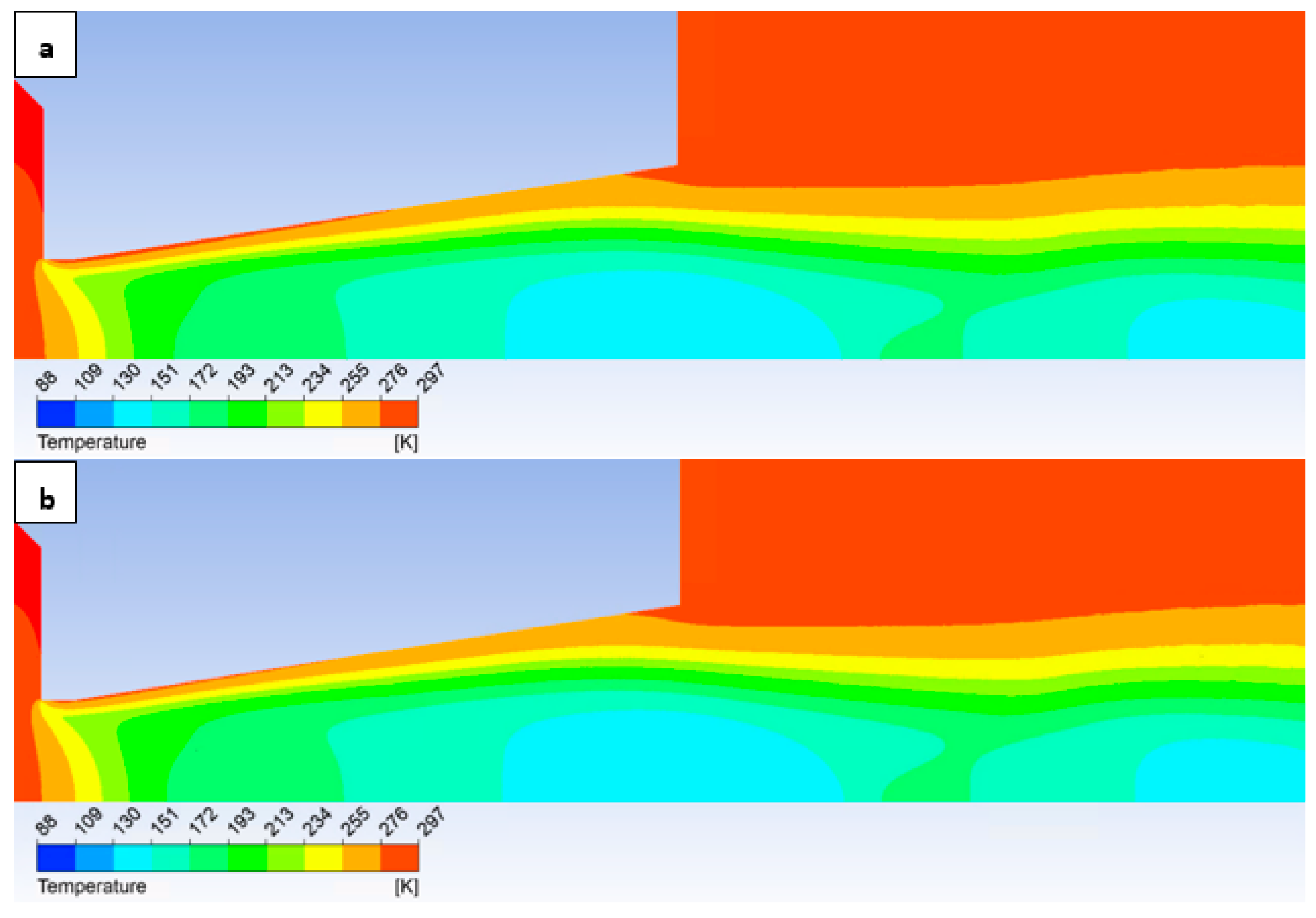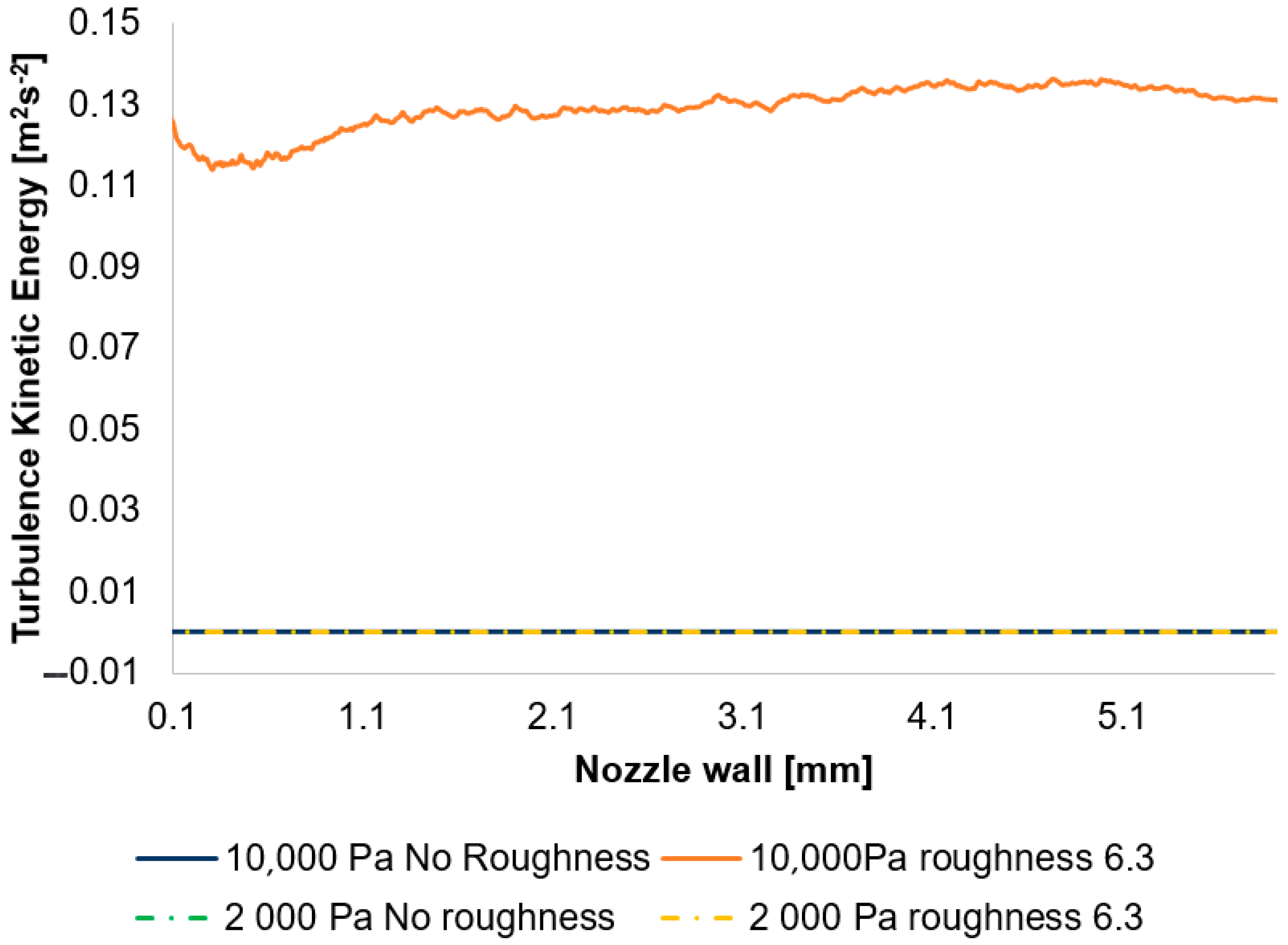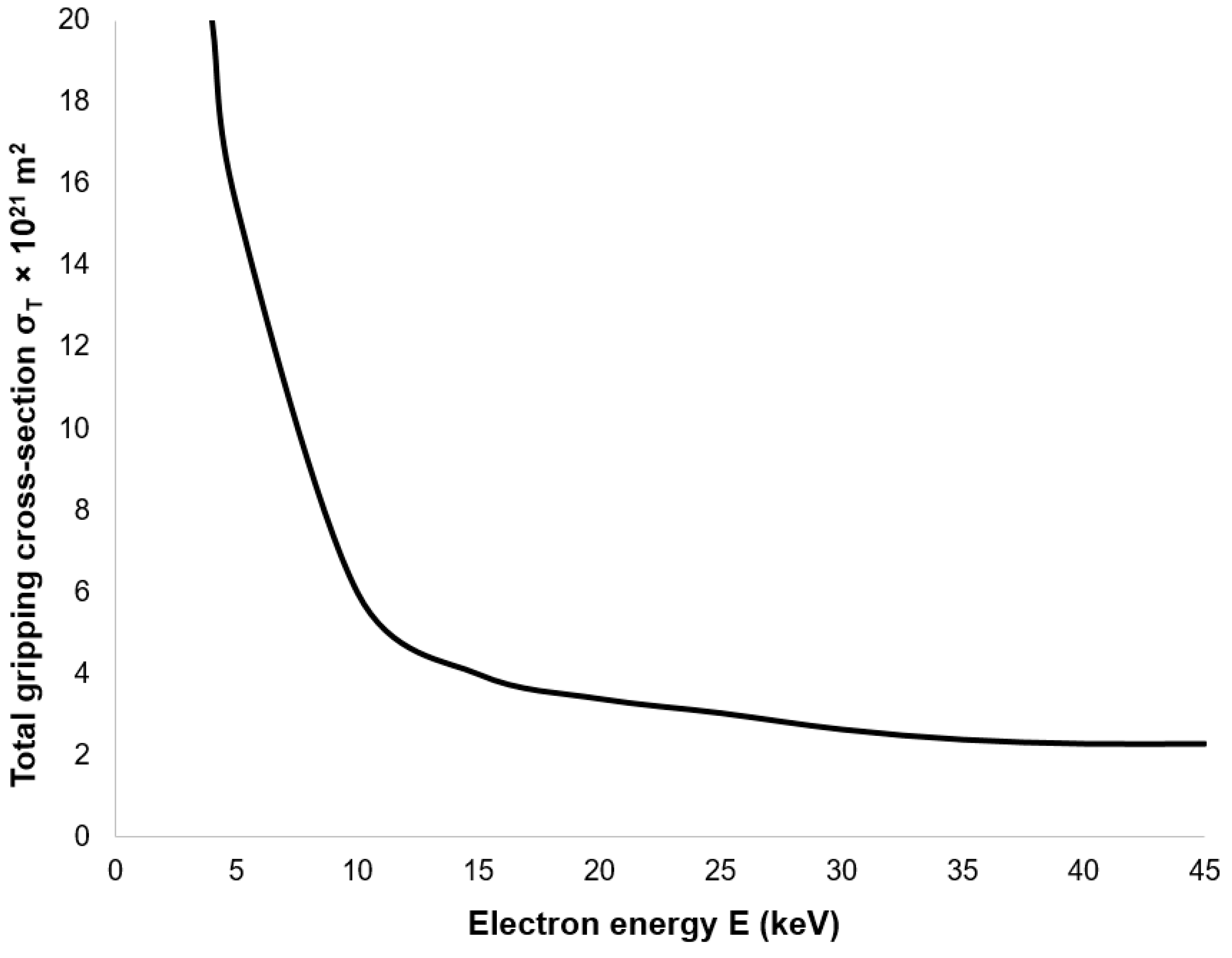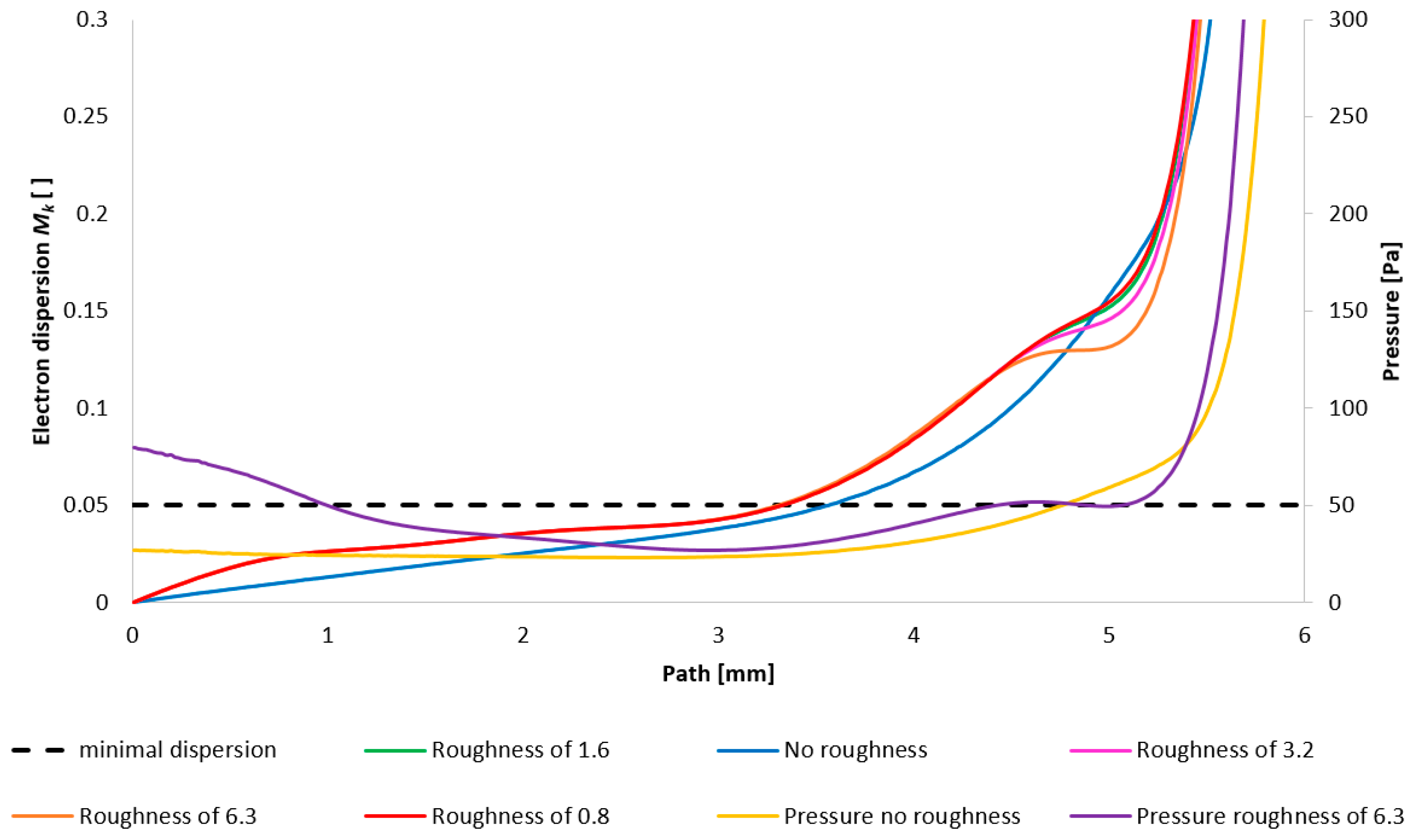3.1. Experimental Measurement of Static Pressure Within the Experimental Chamber
The initial experimental measurement of static pressures on the nozzle wall was conducted on the above-mentioned experimental chamber. A schematic representation of the pressure measurement locations within the experimental chamber is depicted in
Figure 6. It is important to note that the experimental measurements on this nozzle were performed under underexpanded nozzle conditions for a pressure ratio of V1:V2 = 10:1. This was motivated by the objective of generating oblique shock waves within the nozzle, which are analyzed in this experiment to investigate the influence of the modified ratio of inertial and viscous forces.
The results of the experimental measurements are presented in
Table 2. The experimental measurement variants that will be subsequently compared with CFD analyses are indicated in the column labeled “Abs. pressure in V1”. This designation of variants will be consistently used hereafter. Nevertheless, for all variants, an effort was made during the experiment to maintain an approximately consistent pressure ratio between chambers V1 and V2, specifically a pressure ratio of 10:1.
A comparison of the layout of these variants is depicted in the graph in
Figure 8 top. For enhanced illustration of the phenomenon occurring around measurement point 4, the scale in
Figure 8 bottom has been modified. Initial analyses of the results demonstrate that the oblique shock wave impinging upon the boundary layer within the nozzle induces a pressure increase (to be discussed further). It is evident that the altered ratio of inertial to viscous forces under low pressure conditions influences the characteristics of this shock wave. This manifests as a reduced impact of the shock wave on the boundary layer within the nozzle, to the extent that for variants below 3000 Pa, this increase does not occur, or alternatively, this discontinuity shifts away from the aperture towards the nozzle throat and becomes negligible.
Eight repeated experimental measurements of pressure differentials were conducted for the aforementioned pressure ratios, and the averaged values were utilized for further analysis. To evaluate the measurement error, the Standard Error of the Mean (SEM) methodology was employed. The SEM represents the standard deviation of the sampling distribution of the sample mean, derived from data obtained as a random sample from the population. It is a quantity that indicates the extent to which the obtained sample mean is likely to deviate from the true population mean.
The evaluation was performed based on Equation (19):
where
σ [Pa] is the standard deviation of the sample, and
n is the quantity of data points from which the mean was evaluated.
As presented in
Table 3, which provides an example for the 2000 Pa variant, the mean error of the average did not exceed 1.5 Pa. The labels in
Table 3 correspond to those in
Figure 7.
Subsequently, a comparison of the selected experimental result variants with the CFD analyses was conducted. This comparison, along with the measurement error, is presented in
Table 4.
This comparison is depicted in
Figure 9, top, alongside a graph with a modified scale for enhanced clarity (
Figure 9, bottom). This comparison reveals a relatively small error, which is considered acceptable given that a deviation of up to 20% signifies a successful measurement. This demonstrates that the fine-tuned variant within the Ansys Fluent system, which was ultimately employed, is appropriate for the given type of physical conditions in the differentially pumped chamber calculation.
Naturally, further investigation will be conducted into the reason for the elevated error observed in the region downstream of the oblique shock wave in low-pressure variants. This discrepancy stems from the fact that the flow, as recorded experimentally, exhibits lower velocities than those predicted by the results obtained from the Ansys Fluent system. This phenomenon will constitute a part of our subsequent research, where it is likely that the ratio of inertial to viscous forces plays a significant role, even within the realm of continuum mechanics.
The results presented in this manuscript will furthermore serve as a foundation for subsequent experiments. These will include pressure measurements on the nozzle walls and along the flow axis, utilizing nozzles with precisely defined roughness. The selection of these experiments will be based on the outcomes achieved in this manuscript.
Following this, two specific variants, incorporating the defined nozzle wall roughness as detailed in the Methodology chapter, were subjected to comparative analysis. The results demonstrated that the inclusion of nozzle wall roughness led to an even closer agreement between the CFD analysis and experimental findings. A more comprehensive discussion of these observations, including a detailed analysis of these CFD variants, will be presented later in this paper.
3.2. The Influence of Surface Roughness in the 10,000 Pa Variant
Analyses were conducted with nozzle wall roughness set at fundamental roughness scale values: No roughness, Ra = 1.6, Ra = 3.2, and Ra = 6.3. Subsequently, these analyses were compared with experimental pressure measurements obtained from the surface of a nozzle manufactured with a production tolerance of Ra = 1.6.
The values presented in
Table 5 were obtained through CFD analyses, wherein the nozzle wall roughness was defined according to the methodology detailed above. Concurrently, the table also includes the relative measurement error and the average relative measurement error for the entire roughness variant. The results indicate that the Ra = 6.3 variant exhibited the largest error in relation to the experimentally acquired value. The second largest error was observed in the No roughness variant. Thus, roughness has a discernible influence on the accuracy of CFD simulations, although the error appears negligible. The experimental nozzle was manufactured with a roughness of Ra = 1.6, which resulted in a CFD analysis error of less than 1%. Surprisingly, variants with higher roughness (Ra = 3.2) demonstrated even smaller errors, with the Ra = 3.2 variant being the most accurate. This effect may be attributed to the possibility that the manufactured nozzle’s roughness was closer to the Ra = 3.2 value within manufacturing tolerances. However, it appears more likely that, within the spherical roughness modeling methodology, the Ra = 3.2 roughness setting corresponds more accurately to the actual manufactured roughness of Ra = 1.6, which possesses sharper features. The premise that the actual roughness may be higher will be rigorously investigated in a subsequent study utilizing newly manufactured nozzles with precisely defined roughness characteristics. Nevertheless, it may be demonstrated that a spherical roughness, when applied to the problem of boundary layer detachment, exerts a less significant effect than the actual roughness value Ra.
This variant demonstrated that higher roughness values exhibited agreement with experimental measurements. The data thus obtained from experimental measurements contributed to the refinement and verification of the Ansys Fluent system. Subsequently, an analysis of the flow characteristics will be presented, utilizing the results acquired from the Ansys Fluent system.
A comparison between the experimental results and those obtained from CFD analyses demonstrates that the data derived from the CFD analysis exhibit a high degree of accuracy when compared to the experimental measurements. The correlation between the experimental results and the CFD simulation outcomes is illustrated in
Figure 10.
The subsequent analysis investigated the flow field within the CFD simulations. This contemporary approach, effectively integrating experimental measurements with CFD simulations, provides significant added value to the research. In this instance, experimental data acquisition describes the distribution of variables at selected points and serves to verify the CFD simulations. Concurrently, the CFD simulations offer a detailed description of the entire domain.
Initially, the pressure and temperature distribution along the nozzle wall was analyzed, as the experimental pressure measurements are focused on this region at this stage of the research. Temperature measurements using sensors are planned for the near future.
Figure 11 illustrates the specific path along which these quantities were extracted (referred to as “nozzle wall” in the graphs).
Figure 12 illustrates the static pressure distribution along the nozzle wall. A discontinuity resulting from an oblique shock wave is evident at approximately the 4.3 mm position. The region of this discontinuity, encircled in red, is presented in magnified form in
Figure 12, bottom, using a modified scale to accentuate the differences between the configurations.
Figure 12, bottom, employing a modified scale, clearly demonstrates that the pressure loss increases with increasing surface roughness. The difference between the No roughness variant and the Ra = 6.3 variant reaches up to 30 Pa. Furthermore, the Ra = 3.2 and Ra = 6.3 variants exhibit the smallest deviations when compared to the experimental measurements. This constitutes a significant finding for future research in the field of ESEM development.
The temperature layout along the nozzle wall (
Figure 13) demonstrates the anticipated correlation with the static pressure layout, thus providing a suitable basis for validation.
It is pertinent to note that on the x-axis of
Figure 13, an unexpected phenomenon occurred whereby the retention of a highly granular division resulted in a jagged graphical representation. This issue was resolved through a refinement of the discretization and a subsequent revision of the results. This demonstrated that the observed irregularity was not attributable to an error stemming from a solution dependency on an inappropriately generated discretization mesh.
In this particular case, the analysis pertains to a region where the magnitude of inertial forces significantly diminishes due to low pressure, whereas the viscous forces remain independent of pressure magnitude up to 133 Pa. Consequently, in the scenario under investigation, viscous forces exhibit significant dominance.
When inertial forces are negligible relative to viscous forces, the flow tends to exhibit laminar characteristics. In such flow regimes, the boundary layer is generally less stable and highly susceptible to separation in the presence of an adverse pressure gradient. This phenomenon is particularly pertinent in cases where a shock wave impinges upon the boundary layer within the divergent section of the nozzle. A separation of the laminar boundary layer would result in substantial pressure losses and a reduction in the nozzle’s effective cross-sectional area.
Under these conditions, the increased wall roughness in this specific case influences the boundary layer by inducing a premature transition from laminar to turbulent flow. The resulting turbulent boundary layer exhibits significantly greater resistance to separation compared to its laminar counterpart. This enhanced resilience is attributed to its higher kinetic energy near the wall, which enables it to more effectively overcome pressure increases and maintain attachment to the surface.
If roughness prevents boundary layer separation, the flow remains more effectively attached along the entire length of the nozzle. This maintains a larger effective cross-section for the flow and minimizes losses caused by recirculation regions that arise from separation. Consequently, the flow can achieve a higher velocity.
This case is highly specific due to the significantly different ratio of inertial to viscous forces, where increased roughness leads to improved conditions for boundary layer stability.
The oblique shock wave referenced above is illustrated in
Figure 14, which depicts the pressure gradient distribution. The following figures show both variants of the opposite spectrum, i.e., the No roughness variant (
Figure 14a) and the Ra = 6.3 variant (
Figure 14b).
Figure 14 shows the character of an oblique shock wave using a pressure gradient, the influence of which decreases with decreasing pressure. This shock wave influences the boundary layer (
Figure 15a). An enlarged view of this region with a modified scale is presented in
Figure 15b, highlighting these pressure gradients.
However, with a suitable scale setting, it is evident in
Figure 15 that for the variant with roughness Ra = 6.3 (
Figure 15b), the shock wave has a greater tendency to interact with the boundary layer, which results in the above-mentioned influence on the pressure and temperature profile on the nozzle wall. This interaction influences the subsequent analysis in the flow axis.
Analysis of the 10,000 Pa variant reveals a distinct interaction between the oblique shock wave and the boundary layer. This interaction influences the evolution of state variables along the flow axis due to boundary layer separation. Larger and sharper surface irregularities exert a more significant impact on this separation. The influence of surface roughness increases with augmenting flow velocity. However, this effect is less pronounced with decreasing pressure, as will be demonstrated subsequently in the analysis of the 2000 Pa variant.
Subsequent analysis presents the flow profile along the nozzle axis, which may be influenced by boundary layer behavior.
Figure 16 illustrates the trajectory along the flow axis, upon which selected state variables are subsequently plotted (denoted as “Flow Axis” in the graphs).
Figure 17 illustrates the Mach number distribution, with a highlighted region affected by shock wave interactions with the boundary layer, as previously described. The area impacted by these shock waves is indicated by a red circle in
Figure 17, top.
Figure 17, bottom, provides a magnified view of this region, revealing flow alterations within the nozzle due to oblique shock waves. The results suggest that increased surface roughness leads to a higher flow velocity downstream of the aperture until the velocity decreases due to the formation of an oblique shock wave, which causes a velocity reduction but not below 1 Mach. As evidenced by the results presented in
Figure 17, an increase in velocity downstream of the aperture, prior to deceleration induced by the shock wave, is observed to be 8.25% with increasing roughness.
The Mach number distribution indicates that this phenomenon results in a more pronounced pressure drop upstream of the oblique shock wave (
Figure 18 with the enlarged, red-circled region in
Figure 18, bottom). This finding may have implications for the electron beam scattering upon traversing the differentially pumped chamber. This is partly due to the aim of achieving a lower average static pressure along the flow axis, but primarily because this region is in close proximity to the aperture, which is generally an area of relatively high pressure and thus exerts a greater influence on electron beam scattering.
To facilitate a more comprehensive understanding of the flow characteristics, temperature profiles are also included, correlating with the Mach number and the static pressure distribution along the specified flow axis (
Figure 19, top, with the magnified red-circled region shown in
Figure 19, bottom). The temperature in regions exhibiting high Mach numbers decreases to cryogenic levels. The discrepancies observed between different variants reach up to 10 K.
In conclusion to this subsection, a cursory comparison can be made between two contrasting roughness configurations: No roughness variant and a set roughness of Ra = 6.3, as depicted in the figures illustrating the Mach number, static pressure, and temperature distributions. This is to facilitate the observation of the previously described discrepancies along the flow axis throughout the entire volume.
Figure 20 illustrates the Mach number distribution for the No roughness variant (
Figure 20a) and a variant with a surface roughness of Ra = 6.3 (
Figure 20b). Within the nozzle, at the location indicated by the black circle, the previously described distinct behavior of the Mach number profile is evident. The configuration with a surface roughness of Ra = 6.3 exhibits an increase in flow velocity closer to the aperture. Boundary layer separation alters the velocity profile within the flow. In the region of separation, reverse flow develops, leading to an augmentation of velocity along the flow axis as the flow is deflected away from the surface. It is apparent that this increase primarily concerns the flow axis, through which the primary electron beam passes.
The selection of the presented range of surface roughness was motivated by the comparison of roughness influence on the flow characteristics within a small nozzle, typical of ESEM applications. The chosen scale extends from a very finely ground surface (Ra = 0.4–0.8) to a comparatively high roughness achieved through machining with a rapid feed rate (Ra = 6.3). This upper value is primarily of academic interest for the purpose of gaining insights into the flow regime, as it inherently introduces other complexities, which will be discussed subsequently.
Given the aforementioned dependencies between the Mach number and static pressure,
Figure 21 illustrates the static pressure distribution. Notably, in the case of Ra = 6.3 (
Figure 21b), a discernible pressure decrease is evident extending towards the vicinity of the aperture. Considering that the region proximal to the aperture represents the most sensitive area for electron beam scattering due to elevated pressure levels, coupled with the fact that the primary beam has traversed the longest path through non-high vacuum conditions at this point, this observation is significant [
36,
37].
To provide a complete overview, the temperature distribution is depicted in
Figure 22. These findings will be significant in future work, where temperature measurements are planned utilizing temperature sensors (a custom-made Type K thermocouple with a 3 mm diameter).
3.3. The Influence of Surface Roughness in the 2000 Pa Variant
For the 2000 Pa variant, further analyses were conducted with selected nozzle wall roughness settings: No roughness, Ra = 1.6, Ra = 3.2, and Ra = 6.3. These are again compared with the experimental results, and this comparison is presented in
Table 6.
Even in this variant, it is evident from
Table 6 that the variant with a set roughness value of Ra = 3.2, followed by the variant with a set roughness value of Ra = 1.6, exhibits the smallest error. Both of these variants demonstrate an error margin of approximately 7%. In contrast to the previous configuration, further increases in the roughness value result in a larger error than the variant without roughness on the nozzle wall.
The issue concerning the higher relative error observed at certain measurement points is consistent with the description provided in
Table 4.
Subsequently, a further analysis of the flow characteristics will be presented using results obtained from the Ansys Fluent system. Initially,
Figure 23 illustrates the correlation between experimental results and CFD analysis outcomes.
In the subsequent CFD analysis, the pressure and temperature distribution on the nozzle wall were initially analyzed (
Figure 11).
Figure 24 illustrates the static pressure distribution along the nozzle wall. A discontinuity caused by an oblique shock wave is apparent at approximately the 4.5 mm position. The region of this discontinuity (encircled in red) is magnified in
Figure 24, bottom, using an adjusted scale to emphasize the differences between the variants.
Figure 24, bottom, further clearly demonstrates that, as in previous cases, the pressure loss continues to increase with increasing surface roughness; however, with the reduced pressure in this variant, this increase is less pronounced. The difference between the “No roughness” variant and the Ra = 6.3 variant is approximately 10 Pa. Again, the Ra = 3.2 and Ra = 1.6 variants exhibit the smallest deviations when compared to the experimental measurements.
The temperature layout along the nozzle wall, as depicted in
Figure 25, demonstrates the anticipated correlation with the static pressure distribution, thereby providing a basis for the aforementioned planned validation.
In this variant, the shock wave weakens again, and for improved visualization, the scale in
Figure 26 displaying the pressure gradient distribution had to be reduced by an order of magnitude.
Consistent with the previous observation under appropriate scaling of the static pressure,
Figure 27 reveals that for the variant with a roughness of Ra = 6.3 (
Figure 27b), the shock wave exhibits a greater propensity to interact with the boundary layer. This interaction, as observed previously, induces alterations in the pressure and temperature profiles at the wall and consequently influences the analysis along the streamwise direction. However, the magnitude of this difference is notably diminished in this instance.
Figure 28 once again illustrates the Mach number distribution, with a highlighted region affected by shock wave interactions with the boundary layer, as previously described. The area impacted by these shock waves is indicated in red in
Figure 28.
Figure 28, bottom, provides an enlarged view of this region, revealing the flow modifications within the duct induced by oblique shock waves. Consistent with earlier findings, a higher surface roughness results in an elevated flow velocity downstream of the orifice plate until the velocity decreases due to the formation of an oblique shock wave. However, with decreasing pressure, these differences also diminish [
38,
39].
The results correlate with, for instance, the publication [
40], where the influence of internal surface roughness on pressure drop in a small-diameter pipe was similarly determined using the Ansys Fluent system. The findings indicated a higher pressure drop in the rough pipe compared to the smooth pipe, which agrees with previously published works [
41]. An increase in the wall roughness value demonstrated that further augmentation of roughness corresponds to an increase in pressure drop, albeit not proportionally. Consequently, the effect of internal surface roughness on pressure drop in small piping demonstrates its contribution to increased pressure drop. However, these analyses were conducted under standard pressure conditions. The presented paper aims to analyze this influence under low pressure, where the impact of induced drag and nozzle surface roughness on the flow may differ. Induced drag is a complex phenomenon that manifests during fluid flow around bodies. In the case of a nozzle, it refers to the resistance generated due to changes in the fluid flow direction. This change in direction induces vortices and turbulence, which dissipate a portion of the fluid’s energy, thereby increasing the overall system resistance. The surface roughness of the nozzle further complicates this phenomenon. Irregularities on the nozzle surface cause the fluid flow to become even more turbulent. Fluid particles are deflected by these irregularities, leading to the formation of additional vortices and energy losses.
Surface roughness has the potential to induce a modification in the fluid velocity profile across the nozzle’s cross-section. This alteration can consequently impact downstream flow parameters, such as pressure loss, and significantly within the area of investigation along the flow axis, through which the primary electron beam traverses in practical applications.
Again, as evident in
Figure 29, the variants exhibiting a higher rate of velocity increase conversely demonstrate a more significant pressure drop, approximating over 100 Pa in the vicinity of the diaphragm. However, this difference is again less pronounced compared to the variants with higher pressure.
Furthermore, temperature profiles correlating with the Mach number and the static pressure distribution along the specified flow axis (
Figure 30) are also included as a basis for subsequent planned experiments. The temperature in regions exhibiting high Mach numbers decreases to cryogenic levels.
In conclusion of the analysis of the given variant, a cursory comparison can also be made between two contrasting scenarios: the “No roughness” variant and the variant with a set roughness of Ra = 6.3, as depicted in the Mach number, static pressure, and temperature distribution plots.
Figure 31 illustrates the Mach number distribution. For the given configuration, no significant differences are discernible in the depicted Mach number distribution. Due to the subtle variations, these observations were more readily apparent in the graphical representation presented in
Figure 28. In contrast to the preceding configurations, the current variant lacks the small regions of elevated flow velocity that extended along the axis towards the diaphragm in the former cases.
Consequently, even in the static pressure distribution (
Figure 32), significant differences are not readily apparent upon visual inspection. These rather necessitate analysis within the graphs (
Figure 29).
To ensure comprehensive information, the temperature distribution is once more visually represented in
Figure 33.
As previously stated, the discrepancy observed in the 2000 Pa variants is no longer as pronounced as that in the 10,000 Pa variants. This distinction can be illustrated by examining the distribution of turbulent kinetic energy (TKE) evaluated at the nozzle wall (
Figure 34).
TKE indicates the intensity of turbulent velocity fluctuations. For this analysis, it is possible to focus on the following influences:
Intensity of Mixing in the Boundary Layer: A higher TKE value denotes a more efficient mixing process within the boundary layer, which, in turn, affects both the velocity profile and other inherent characteristics of the boundary layer.
Within the turbulent boundary layer, shear stress continuously generates TKE, which can subtly influence the stability and evolution of the boundary layer.
The TKE influences effective viscosity, thereby affecting both the thickness and the shape of the boundary layer’s velocity profile.
In this instance, the discrepancy among individual variants is negligible; only in the case of the 10,000 Pa roughness of the 6.3 variant is it notably elevated (
Table 7).
An exceptionally low to near-zero TKE signifies laminar flow, a condition arising in this context from a highly specific continuum mechanics regime where inertial forces are substantially reduced, concurrently with a strong dominance of viscous forces.
A significant outcome of the CFD simulations is the observation that for the 2000 Pa variant, an increase in roughness exhibits only a minimal influence, whereas for the 10,000 Pa variant, elevated roughness leads to a heightened intensity of turbulence at the nozzle wall. This effect is attributable to the interaction between the boundary layer and the “core” flow.
The influence on the axial flow velocity is significantly governed by the boundary layer thickness. An elevated value of TKE and its dissipation at the wall indicate more intense mixing within the boundary layer, leading to its growth. A pivotal role in this phenomenon is played by the displacement thickness. This parameter quantifies the effective thickness of a solid wall that would need to be added to the nozzle to compensate for the decelerating effect of the boundary layer on the effective flow area. Consequently, a greater TKE results in a thickening of the boundary layer, thereby reducing the effective flow area. If the effective flow area diminishes due to a thicker boundary layer, the core flow within the nozzle must accelerate more intensely than would be the case in an ideal (inviscid) flow with the given geometry. For a constant mass flow rate, a reduction in the effective cross-section necessarily leads to an increase in velocity.
The values of pressure and temperature are directly dependent on this phenomenon, exhibiting a corresponding decrease. Crucially, wall turbulence impacts the core flow primarily through the modification of the boundary layer thickness and total pressure losses, rather than by direct heat or momentum transfer from turbulent eddies at the wall to the center of the flow.
This research into the distinct characteristics of supersonic flow under the operational pressures of an Environmental Scanning Electron Microscope (ESEM), which are distinguished by a significantly different ratio of inertial to viscous forces, and the specific influence of wall roughness on the nozzle, is of paramount importance. Advances in the development of Advanced ESEM (A-ESEM) operating with higher sample chamber pressures (up to 5000 Pa, exceeding conventional values) specifically necessitate this research to analyze the potential utility of roughness for reducing scattering, which will enable a further enhancement of image sharpness.
3.4. Evaluation of Electron Dispersion for Each Variant
The findings discussed above are applied to the aforementioned domain of ESEM research. The pressure gradient exerts a profound impact on the electron beam dispersion as it traverses the differentially pumped chamber. Within the ESEM, a portion of the primary electron beam retains its original trajectory subsequent to its passage through the gaseous medium. These unscattered electrons are then capable of interacting with the specimen and generating a signal, analogous to that of a conventional electron microscope.
During the primary electron passage beam through a gaseous medium at elevated pressures, electrons may undergo collisions with atoms and molecules, resulting in energy loss and directional deflection. The extent of deviation from the initial trajectory is contingent upon the number of collisions (
Mk). When
Mk is low, the electron’s path remains comparatively undisturbed. Under such conditions, the path length of the electron can be approximated as equivalent to the thickness (d) of the gas layer traversed. The mean number of collisions per electron can be determined using Equation (20) [
36].
where
σT is the total gas gripping cross-section,
P is static pressure,
d is the thickness of the gas layer through which the electron passes,
k is the Boltzmann constant, and
T is the absolute temperature.
The magnitude of the total gas gripping cross-section decreases with increasing primary electron energy, as illustrated in
Figure 35. From a collision perspective, it is therefore advisable to select the primary electron energy just beyond the “bend” in this characteristic, thereby minimizing the scattering of the primary electron beam.
Consequently, the value of
Mk dictates the beam dispersion as follows: if
Mk < 0.05, the beam dispersion is minimal, not exceeding 5%; if
Mk is within the interval [0.05, 3], partial dispersion occurs, ranging from 5% to 95%; and if
Mk > 3, complete dispersion is observed, exceeding 95%. The gripping cross-section, denoted as
σT, represents the close proximity area of a gas particle. A collision eventuates if the electron occupies this spatial location during its transit. Therefore, the gas gripping cross-section is contingent not solely upon the gas species but also upon the accelerating voltage. For the present study, nitrogen was selected in conjunction with an accelerating voltage of 10 keV. Under these conditions, the gripping cross-section
σT is given as 2 × 10
21 m
2, according to reference.
Figure 16 illustrates the path traversed by the primary electron beam through the nozzle in a practical ESEM. The nozzle has a length of 5.941 mm. The primary electron beam propagates counter to the direction of the flow [
37].
In practice, the trajectory of the primary beam through the differentially pumped chamber in an ESEM is typically 6–8 mm in length, and the flow dynamics are influenced by this confined spatial extent. These findings will serve as a foundation for subsequent analysis under ESEM conditions.
Figure 36 illustrates the resultant impact of nozzle wall roughness on the primary beam dispersion for the variant of 5000 Pa. The evaluation of the primary electron beam scattering was performed directly on a model constructed according to the actual dimensions of a real ESEM.
Figure 37 then depicts the configuration with the lower pressure (1000 Pa variant). Evident in this representation is the phenomenon inferred from prior analyses: that the influence of roughness on the flow field diminishes with decreasing pressure. Consequently, the impact of roughness is less pronounced here compared to the 5000 Pa configuration. It is pertinent to note that this analysis solely addresses the effect of the flow field on beam scattering. Beam dispersion is influenced by a multitude of factors, one of which is the surface roughness itself, exerting a detrimental effect. Therefore, a comprehensive perspective on the entire problem is necessitated.
This research broadly addresses differential pumping conditions within Environmental Scanning Electron Microscopes (ESEMs), with this particular article specifically extending its scope to novel investigations in Advanced Environmental Scanning Electron Microscopy (AESEM). This direction of research is significantly advanced by Vilém Neděla from the Institute of Scientific Instruments of the Czech Academy of Sciences (UPT AVČR), through the development of novel observation methods, including detectors that facilitate ESEM operation at pressures higher than currently conventional. Consequently, this research concurrently investigates the potential for reducing electron beam scattering by roughening the nozzle surface. This approach is predicated on the phenomenon that, at these low pressures, the boundary layer will thicken, leading to a reduction in the effective flow cross-section. A critical consideration, however, is that due to the high ratio of viscous to inertial forces, significant boundary layer separation is averted. This methodology thus yields an improvement in the velocity and pressure conditions that are conducive to a reduction in electron beam dispersion.
